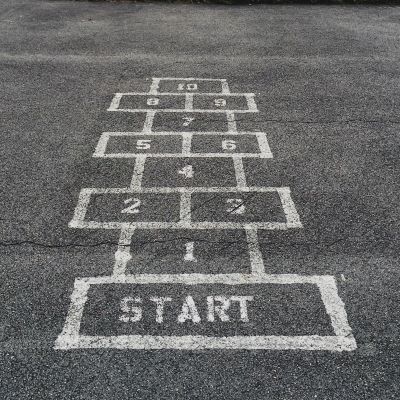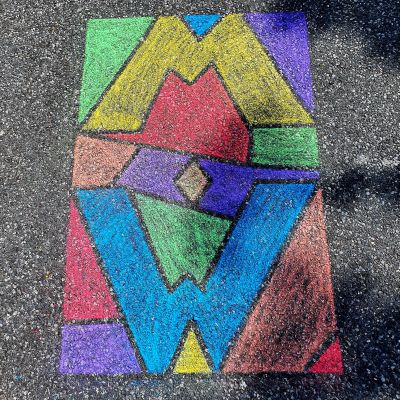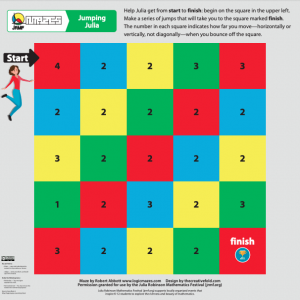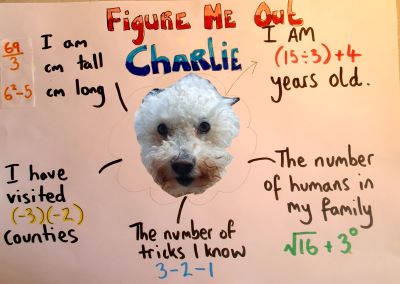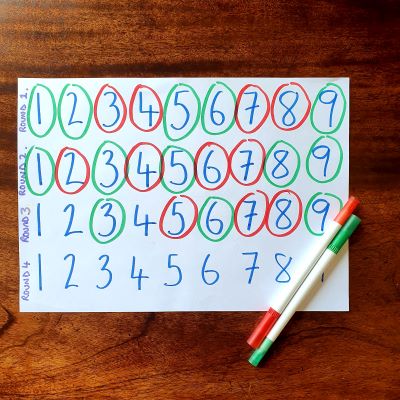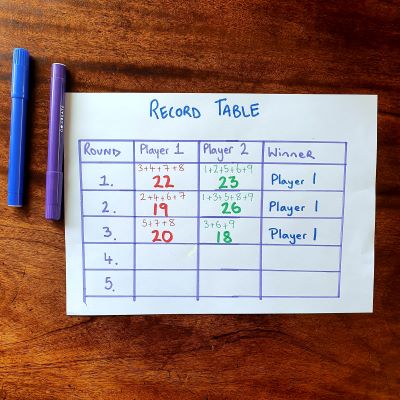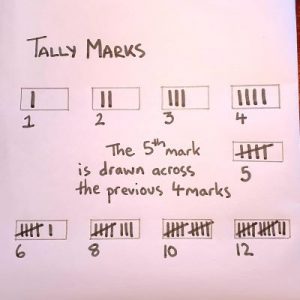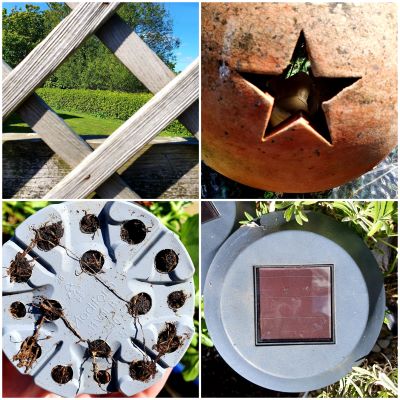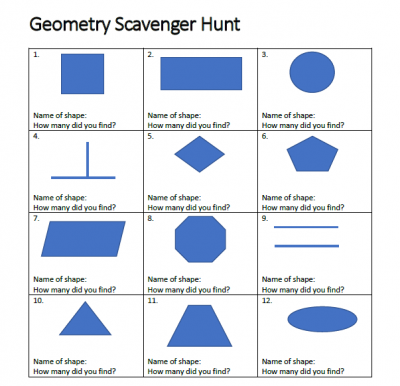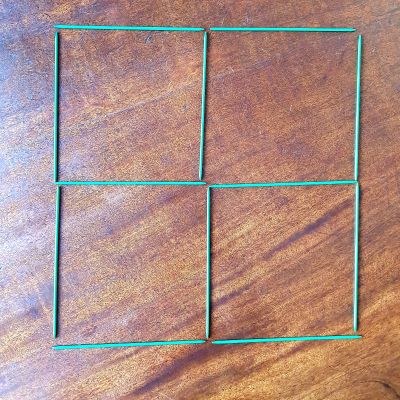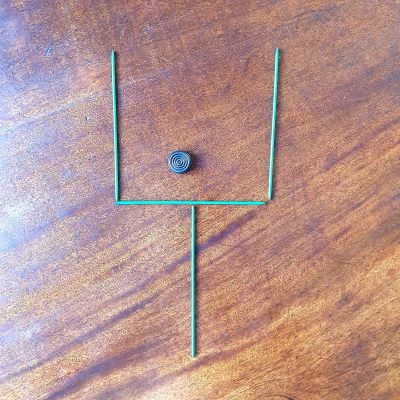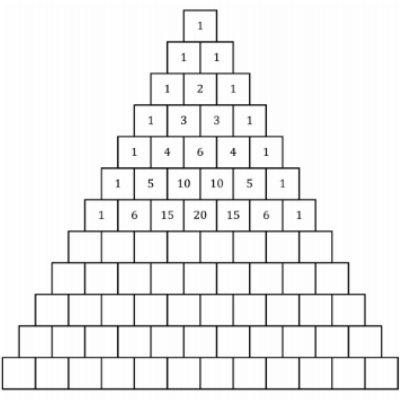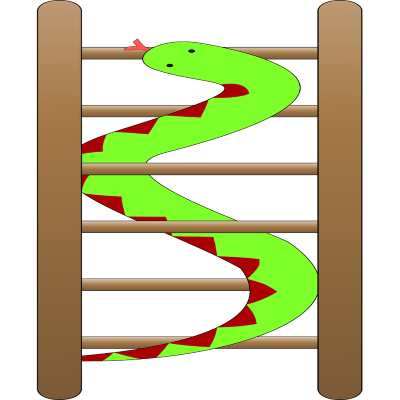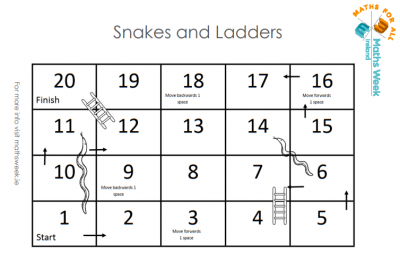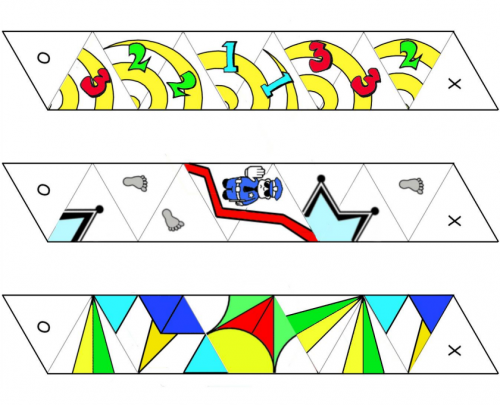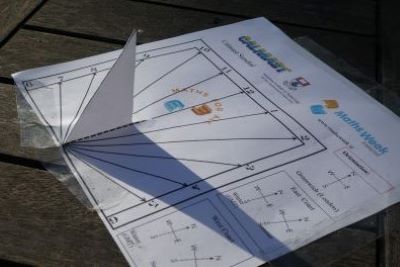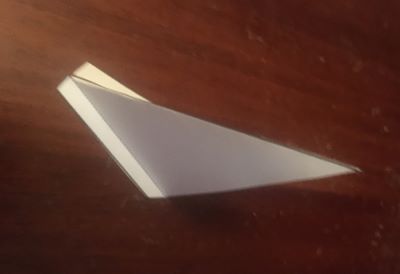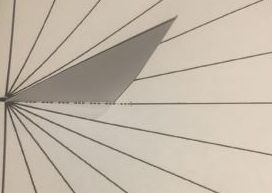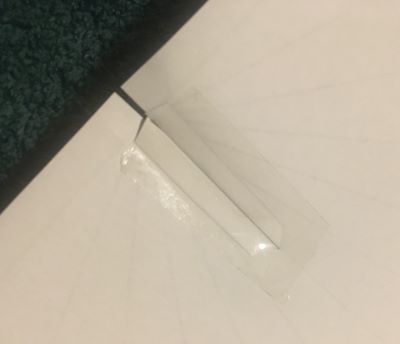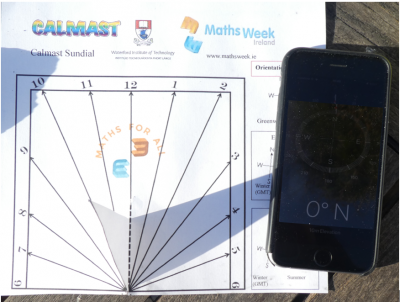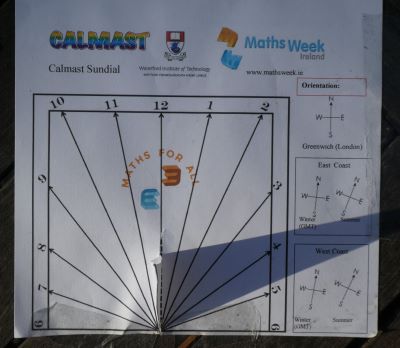Maths at Home Activities
Scroll and explore our range of Maths At Home Activities!
Note: This page may be slow to load as there is a lot of content.
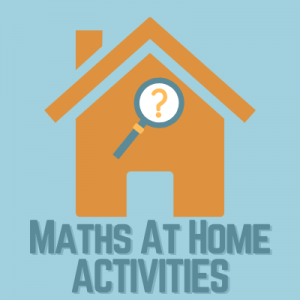
Daily Activities
- Chalk Fun (29/05/20)
- Figure Me Out Poster (28/05/20)
- Twenty Wins (27/05/20)
- Six Frogs Problem (26/05/20)
- Geometry Yes No Game (25/05/2020)
- Biodiversity Day Scavenger Hunt (22/05/2020)
- Design A Biodiversity Garden (21/05/2020)
- Bee Symmetry (20/05/20)
- Quadrat Sampling (19/05/20)
- Bird Survey (18/05/20)
- Countdown (15/05/20)
- Add or Subtract (14/05/20)
- What is the Question (13/05/20)
- Geometry Scavenger Hunt (12/05/20)
- Place Value Battle (11/05/20)
- Sticky Numbers (08/05/20)
- Magic Squares (07/05/20)
- Towers of Hanoi (06/05/20)
- Coin Puzzles (05/05/20)
- What is the Rule? (04/05/20)
- Matchstick Puzzles (01/05/20)
- Crossing the River (30/04/20)
- Two Primes make a Square (29/04/20)
- A Triangle with a Difference (28/04/20)
- Making Shapes (27/04/20)
- Dastardly Diagrams (24/04/20)
- Mathematical Thinking in the Garden (23/04/20)
- Nature Scavenger Hunt (22-04-20)
- Close Call (21-04-20)
- Monster Calculations (20/04/20)
- Card Trick (08/04/20)
- 3 in a Row (07/06/20)
- Flower Petal Addition (06/04/20)
- Maths in the Media (03/04/20)
- Snakes and Ladders (02/04/20)
- Magic Mind Maths (01/04/20)
- Amazing Flexagons (31/03/20)
- Poisoned Chocolate (30/03/20)
- Make a Sundial (29/03/20)
- Have you got the Time (28/03/20)
- Need a Hand with Maths (27/03/20)
- The Magic of Mobius Strips (26/03/20)
- Make Ten Again! (25/03/20)
- Butterfly Symmetry (24/03/20)
May 12th
May 12th 2020 is the 200th birthday of Florence Nightingale. She is famous around the world as the founder of modern nursing. But she was also a leader in the use of maths in medicine and she used statistics to persuade doctors and the government to make hospitals adopt hygienic practices saving countless lives. Her work promoting hygiene and use of medical statistics is echoed every day in our news during the Covid pandemic. Read more about Florence Nightingale and maths here.
May 12 is also International Women in Mathematics day, celebrating the achievements of women in Maths, and it aims to encourage girls and young women to become more interested in maths. May 12 was chosen as the date to celebrate Women in Maths day as it is the birthday of Maryam Mirzakhani who was born in 1977 in Tehran and later worked in Stanford USA. In August 2014, she was awarded the Fields Medal, the most prestigious award in mathematics. She became both the first, and to date, the only woman and the first Iranian to receive the award. Sadly she died of cancer in 2017.
12 May 2020 is also the 200th birthday of John Casey who was born in Limerick and went to Trinity College Dublin the age of 38. He became a lecturer in the Royal Catholic University (now UCD) and wrote influential textbooks. Find out why Casey is regarded as a father of modern geometry in the recent Irish Times Article by Peter Lynch.
Chalk
Friday 29/05/20
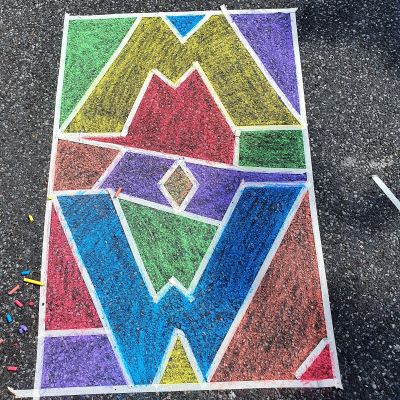
What you will Need
Chalk
Masking Tape or Sellotape
Measuring tape
Geometric Chalk Designs:
Ask the following mathematical questions when you are admiring your work:
- How many sections do we have in total?
- How many parts are pink?
- What colour is the most common? How many?
- Which section has the largest/smallest area?
- Which section has the largest perimeter? How can we be sure?
- What fraction of the design is green?
- What percentage of the design in blue?
- What is the fewest number of colours you can use so that no adjacent sections are the same colour? Can you create a design that requires more colours than your original one?
Resource credit: www.youcubed.org
MAZES:
A maze is great fun and it can be a maths learning experience too!
Mazes offer open ended problem solving for all ages in an imaginative and creative environment. They help people develop mathematical logic skills and require participants to memorise lengthy sequences of moves in a particular order.
Jumping Julia
Help Julia get from start to finish. The number on each square indicates how far you can move. You may jump horizontally or vertically, but not diagonally.
Get the students to design the 5 x 5 square grid:
- discuss the properties of squares – the four sides of the squares should be of equal length.
- Decide on the length of each small numbered square. Then multiply this number by 5 to calculate the length of the overall 5 x 5 grid.
- Students should familiarise themselves with the equipment used to measure length – decide on appropriate units to use and measure out the required dimensions.
Resource credit: Julia Robinson Mathematics festival (jrmf.org)
There are a great range of mathematical mazes. The maze designer Adrian Fisher has created 6 minute mazes – a set of interesting logic mazes used on the streets during Maths Week.
Check out the following links for a variety of mazes
For: primary and secondary students
These logic puzzles will have the whole family engaged they’re always popular at Maths in the City events during Maths Week and can be easily recreated using materials from around the house.
What you need:
Two sets of three items to represent the frogs and 7 places to represent lily pads.
.
INSTRUCTIONS:
- There are 7 lily pads in a line on a pond
- There are six frogs on the pads
- All frogs face the centre
- Three red frogs are on one side and three blue frogs are on the other side
- The red frogs want to be where the blue frogs are and the blue frogs want to be where the red frogs are according to the following rules.
Rules
- Only one frog per lily
- Frogs can jump either onto the next lily or over one frog onto the next lily
- Frogs cannot turn around
- These frogs do not like to get wet
Make up a game with seven places representing the lilies. Choose items to represent the frogs. You can use coins, counters, toys: get creative and have fun. It makes it easier if you have two clearly different sets of three matching items.
Important points for developing problem solving skills
- The important thing is not the end point but what they learn on the way there.
- Perseverance is really important.
- Encourage effort and praise them when they try something new.
- Try to resist suggesting moves. Encourage them to reflect on what they are trying. Suggest strategies instead.
- When a child solves a problem, ask them to explain how they got there.
- Can you identify strategies that could help in other problems?
For: primary school students
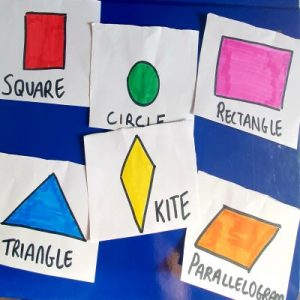
This activity will have children develop their questioning and deduction skills as they communicate their understanding of 2D and 3D shapes.
How many questions will you use to guess the mystery shape?
What you need:
- Pencils
- Paper
.
INSTRUCTIONS:
- Print the cards that will be used to play the game or recreate them at home using paper and pencils. For younger children you can limit the game to the 2D shapes: triangle, square, circle, rectangle, kite. Have the children draw the shapes and write the name underneath.
- Shuffle the cards.
- Each player will randomly pick a card and stick it to their forehead without looking at its contents.
- Player 1 will begin the game by asking a yes/no question, such as “does the shape have 4 sides?”
- If player 2 answers yes, then player 1 gets to ask another question. If player 2 answers no, then the questioning moves to the next player.
- Record the number of questions each player asks using a tally
Check for understanding:
- Do children understand a good range of shape names and properties?
- Can they name and classify the various shapes and describe their properties?
- Do they recognize the properties of rectangles?
- Do the recognise parallel and perpendicular lines?
- Can they recognise a symmetrical shape?
- How many equal sides does an equilateral triangle have?
- Name a shape that has one pair of parallel sides?
BIOLOGICAL DIVERSITY DAY: Mathematical Nature Scavenger Hunt
For: Primary Children
Friday 22/05/20
This cross-curricular fun activity celebrates BIODIVERSITY DAY today. It is great way to get children excited about maths and nature. Children will have to look for certain materials found in nature, count them, record their results and communicate their mathematical thinking. By bringing maths into everyday experiences, like exploring in the garden, children can practice their mathematical skills in a meaningful way. This type of activity will deepen their understanding of mathematical concepts as well contribute positively to their wellbeing: spending time in nature has a very positive effect on our mental and physical health.
Consider the biodiversity of your environment (the variety of living things around us). This week we are celebrating biodiversity across Ireland and all over the world: it is International Day for Biological Diversity on 22 May. We can also celebrate biodiversity right at home. Today’s activity will inspire you to explore and discover what is at your doorstep
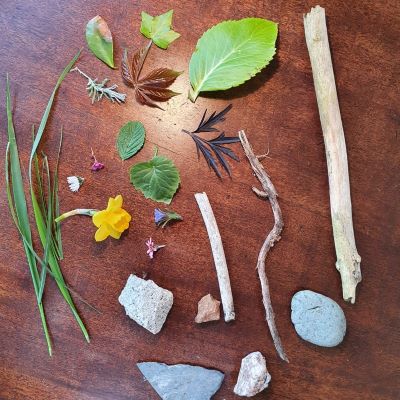
Search for as many of the following items as possible
Fallen leaves:
- How many fallen leaves can you find?
- Collect some samples of different types of leaves – try get as many different shapes as possible
- Draw a sketch of one of the leaves or make a leaf rubbing
- What type of shape does it have?
- What colour is it?
- How would you describe the texture of the leaf? (waxy/smooth/rough/flimsy/bumpy/crumbly)
- Create a pattern collage with the leaves you have collected
Sticks
- How many sticks can you find on the ground?
- Can you collect 10 sticks?
- Which stick is the longest/shortest/thinnest/thickest?
- How would you describe the texture? (smooth/rough/bumpy/hard/crumbly)
- Arrange the sticks in the row, anyway you like/from smallest to biggest
Feathers
- Can you find any feathers on the ground?
- How many can you collect?
- Which feather is the longest/shortest/biggest/smallest?
- Can you draw a sketch of a feather?
- What colour is it?
Flowers
- How many white/pink/yellow/purple flowers can you see?
- Can you find a flower with 2 petals/3petals/4petals/5petals/many petals? count how many you find and record the results
Animals
- Can you find an animal with 0 legs/ 2 legs/4 legs/ more than four legs?
- Record how many of each differen birds you see in your garden. Put a time limit on it.
- Can you find a group of animals together? Birds/insects/cattle/fish? How many?
- Sort the animals in order of size – draw a picture
- Which is the biggest/smallest/fastest/slowest/heaviest/lightest
- Which is the odd one out? Seagull, Robin, blackbird, cat? Cat, dog, butterfly, cow?
- categorise the animals into furry/not furry
Trees
- How many trees can you see?
- Do they have leaves or not?
- How to the tree differ from one another? What are the differences? Similarities?
- If they have leaves, what colour are they?
- Estimate the number the branches/leaves? Is it possible to count?
- How would you describe the tree? (tall/small/wide/thin/bushy/bare)
- Categorize the trees in terms of size – which one is the tallest/shortest? Which has the thinnest trunk?
- Are there any animals in the tree? Count them
- Take a bark rubbing. How would you describe the texture/colour of the bark?
Human made objects:
- What types of objects can you see in your garden that are not natural?
- How would you describe the shape?
- Can you find an object that you think is heavier that this?
Can you find the following shapes?
- straight line,
- curved line,
- square,
- triangle,
- circle,
- cuboid,
- sphere
Patterns and symmetry
- Can you find any interesting repeating patterns?
- Predict what would come next in the pattern if it were to continue
- Can you create your own repeating pattern with some of the materials you collected?
- Can you find something that has 1 line of symmetry? 2 lines of symmetry? Rotational symmetry?
What you will need:
- Pencils
- Hunt list
- Clock
In these difficult times, you may not have all the material suggested. You may need to adapt these activities to suit your needs and materials available. For instance, you could draw out the cards. Maybe your kids could think of ways of adapting and improvising. This is valuable skills development.
INSTRUCTIONS
Create a list before you head out, choose as many items as you like. Check out our template below for ideas. Children may like to be involved in this process – brainstorm what natural materials and wildlife you expect/hope to find in the garden.
As an extra challenge you could extend the scavenger hunt to another location and then add the two together. For example, the front garden and the back garden or the local park and the beach.
Children may like to collect some samples (10 – 20) for an art activity later. Please be considerate of the natural environment and only gather objects that have already fallen to the ground.
How to Play:
- Once you have devised a list, take note of the time on the clock, and then head outside.
- Begin by looking for the first object on your list. Count how many of those items you see. For example, there are 3 trees in the back garden
- Write down that number. Or if there are lots of those items it may be a good idea to keep a tally instead (just put marks on a piece of paper but the 5th mark is drawn across the previous 4 marks (see below)
- You may wish to collect some of the natural items for further analysis later (between 10 and 20 items) e.g. sticks, round pebbles, fallen leaves, blades of grass, flower petals, shells)
- Continue through the list, searching for each of the items. Record how many of each kind you find. Take some sketches, tree rubbings or photographs.
- Don’t forget to take your time and look around – you may see some other interesting items that weren’t on your list. What other maths can you see around you?
- When you’re done, look at the results. Which natural item did you find the most of? The least? Which stick is the longest/shortest/thickest/thinnest etc.
- Record the time on the clock again. How long did you spend scavenging?
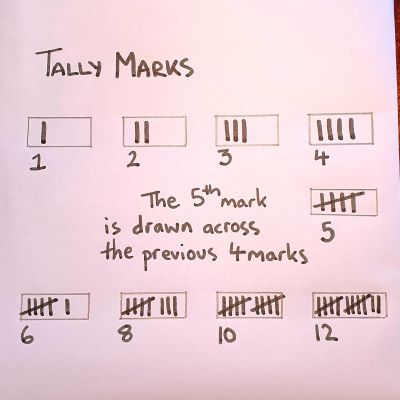
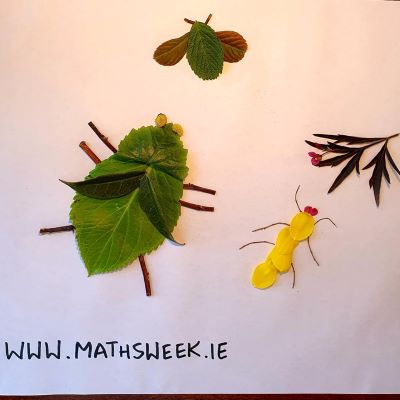
Extensions:
Encourage diversity in your garden and create the following:
- Butterfly feeders
- Insect hotels
- Bird feeders
- Bird bath
- Make a mandala
- Mini greenhouse
All these activities are free to download on the Bealtaine Living Earth Website
Design a Biodiversity Garden
Thursday 21/05/2020
On 22May we are celebrating International Day for Biological Diversity across Ireland and all over the world – but we can also celebrate biodiversity right at home. Today’s activity will inspire you to explore and discover what is at your doorstep. It involves thinking mathematically as you design your own biodiversity garden.
EXTENSIONS:
To show children the advantages of a biodiversity garden, carry out the quadrat sampling activity. This activity will have students apply their maths skills of measure and statistics to monitor biodiversity (the variety of life around us) in two different habitats.
If you plan to introduce some of the design changes to your garden then it would be a great idea to carry out a quadrat sample before and after the changes are made and compare the results.
Thank you to Juanita Browne for the resource on
“Gardening for Biodiversity”
.
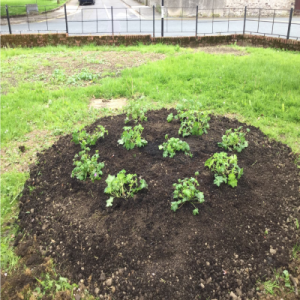
Photo’s of the wildflower garden at Carrick-on-Suir Library

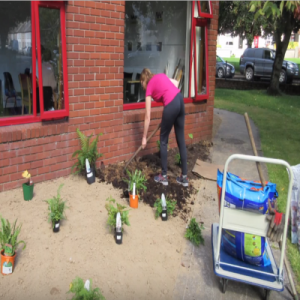
For: upper primary and secondary schools

At the moment biodiversity is in decline across Ireland due to many reasons, one being our increased interest in managing our countryside so as to include more land for housing and infrastructure with manicured gardens which are not inviting for our insect, bird, fish, mammal and plant populations. But with over 2 million domestic gardens on our island, imagine the difference we could make if we made our gardens biodiversity friendly.
What you need:
- Pencils
- Paper
- Measuring Tape
.
- Carry out a site analysis:
Work out the space intended for the garden.
- explore your garden and take notice of the shapes and the materials currently occupying the space
- Measure the perimeter of your garden – add the lengths of all the sides of your garden to find the total perimeter.
- Calculate the area of the garden. If your garden is an irregular shape, then break it up into regular shapes such as rectangles and right-angled triangles; find the area of each shape and then add them together to get the total area.
- Draw a map to scale and use the map to plan your new biodiversity garden designs.
- Track the weather conditions over time. Can you make homemade version of weather instruments and record the average rainfall, hours of sunshine, wind direction?
- Understand the basic geometry:
Observe the structure and the lay out of the garden, this will serve as a framework to better understand the local ecology.
- Identify geometric shapes already present
- Draw geometric designs for the proposed flower gardens
- Consider the need to plant flower seeds in patterns that will enable the best growth possible. Even the smallest balcony gardens look great and grow better with a little consideration to geometry
- Design your biodiversity garden – the wilder the better! The greater variety of plants and animals you share your garden with the better you will feel!
- Research garden magazines, newspapers, and online for ideas for your design. Check out the free booklet “Gardening for Diversity” (available on
- Consider how you will provide FOOD, SHELTER and WATER for animals when you are designing your biodiversity garden. Try include:
- A woodland area which has an abundance of biodiversity
- A Wildflower strip full of flowers for pollinators
- Hedgerows to provide shelter and protection for all types of creatures
- A Pond to provide water for drinking and cleaning
- Design and build bird feeders and bug hotels which will provide food and shelter
- Apply your problem-solving skills as you:
- Devise a schedule for the planting of seeds – by looking at the seed packet determine the optimal harvest date for each crop. Next, knowing how many days-to-maturity, work backwards to work out when each crop should be planted.
- Devise a timetable for the family to help out with the watering and clipping of plants.
- Keep track of the cost benefit of growing vegetables at home – calculate the cost per unit and compare that to store bought produce.
- Plant broad beans in small pots and place one plant in a sunny position and the other in a dark corner. Measure growth every day and draw up a table showing the heights of the two plants each day. Compile the data into a chart and determine the average growth rate of plant grown in light versus dark. Write down two formulae – one for each set of plants – to represent the average plant’s height on any given day.
Bee Symmetry
Wednesday 20/05/2020
Wednesday is World Bee Day but did you know that a teaspoon of honey equals the lifetime work of 12 honeybees? That the nectar of about 2 million flowers gives about 1lb of honey? But that is not all the maths we need to consider when it comes to bees. It becomes much more complex. Bees are highly mathematical: they build their honeycombs in perfect hexagons, the most space efficient shape when stacking objects. They also perform a dance called the waggle dance to inform each other of promising sources of nectar. The waggle dance is aligned to the sun and the source of food to show the direction and indicates the distance between the hive and the source. Recently it was also found that bees even understand the concept of zero – something that mankind was struggling with for a long time! Go to www.livingearth.ie for more buzzare facts about bee’s!!
EXTENSIONS:
- Try this activity again with other insects, such as a ladybug, butterfly, spider, cricket and create an arty ecosystem that is rich in biodiversity
- Explore you house and garden for other objects that are symmetrical.
- Cut out a square and investigate how many lines of symmetry it has. Allow the child to fold along the lines of symmetry to see that both sides are the exact same (a square has 4 lines of symmetry)
- Cut out a rectangle and investigate how many lines of symmetry it has. (a rectangle has 2 lines of symmetry)
- For students in secondary school they could practice the different transformations in geometry, such as reflections, translations, rotations, and dilations. There are fantastic videos on Khan Academy and YouTube. All you need is a ruler and pencil.
Thank you to the National Parks and Wildlife Service for the guide to Ireland’s Common Bumblebee’s
For: young primary school children
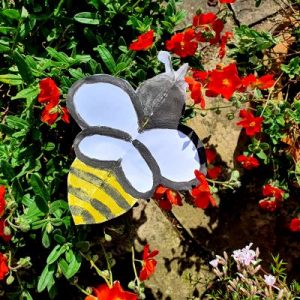
To celebrate World Bee Day, we have a symmetry activity which brings maths and art together. If you have water-based paint, paper, and a scissors you are ready to go.
The type of symmetry children will work with today is Reflection Symmetry, sometimes known as mirror symmetry. One half on the image is the reflection of the other half.
What you need:
- White paper
- Paintbrushes
- Paint
- Pencil
- Scissors
.
INSTRUCTIONS
- Place a piece of paper in front of you and fold it in half, so that the left side touches the right.
- With a pencil, draw one side of the bee on the folded sheet.
- Paint the bee’s head in black and the body with yellow paint. Use the paint liberally, only colouring in one half of the bee.
- Fold over the paper and press together to ensure the paint transfers to the other half.
- Open the paper and you will see a symmetrically shaped bee’s body. (if you need to add more paint and fold again then go ahead and do that)
- Next, on the original half of the sheet, paint in the bee’s stripes and wing outline with black paint.
- Repeat step 4 and 5 again.
- Leave the page aside and allow time for the paint to dry
- Once the paint is dry, you can fold the page in the opposite direction and cut out the bee, making sure you are cutting both sides of the paper.
Quadrat Sampling
Tuesday 19/05/2020
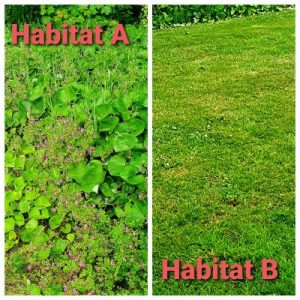
.
The Bealtaine Living Earth Festival celebrates biodiversity and the rich natural heritage in Ireland, predominantly in the South-East region. Check on the website here where they showcase the extraordinary things we all have right here at our doorstep
For: Upper Primary School and Secondary School students
This activity will have students apply their maths skills of measure and statistics to monitor biodiversity (the variety of life around us).
Students will apply methods that mathematicians use – They will take a random sample and measure the abundance of various species in two different habitats (Habitat A: wild meadow & Habitat B: cut grass).
They will compare their results and consider why the levels of abundance and diversity are so different between the two sites.
What you need:
- Measuring tape
- A homemade quadrat
- Record sheets
- Pencils
As an introduction to this activity ask students how they would go about counting the number of different plant species in a large area of grass.
How many daisy plants are there? How many clover plants? etc
Children will realise quickly that it would take a lot of time and effort to study the entire area and record the number of plants and insects.
So instead, mathematicians take a random sample, a small section of the overall area, and then based on the results from the sample they can find out things about the larger area.
We will use a quadrat to take a sample.
EXTENSIONS:
- Present your data with a bar chart. (horizontal axis is the plant species and the vertical axis is the frequency)
- Calculate the percentage of area covered by different plant species, paths, trees, shrubs etc
- Repeat the activity for different times of the year.
INSTRUCTIONS
- Create a quadrat from homemade materials such as cardboard, sticks, hula hoop, etc.
Quadrats can be any size and shape, typically they are squares with lengths of 25 cm by 25 cm or 50 cm by 50 cm but can also include circles and rectangles.
- Record the area of your quadrat. Formulae below.
- Decide on the two habitats you wish to take samples from – one should be overgrown and wild while the other area should be a section of the garden/park where the grass has been cut and maintained. Ideally the area will be at least 5 metres long by 5 metres wide.
- Take measurements of the area you are going to study. Measure the length and the width. Multiple the length by width to calculate the area of a rectangular shape
- Draw a simple sketch of the habitat being observed and include the direction of north, any nearby buildings, large trees and shrubs, pathways etc.
- Work out how many times your quadrat would fit into the larger habitat.
- Take observations of your surroundings and characteristics of the day.
For example: “It is a windy but sunny day. The first area I am surveying is in the local park next to a busy playground. The second area I am surveying is far from the pathway in a quiet area of the park”
- Randomly choose a section of the habitat to place the quadrat – you can do this by throwing a ball/pebble and placing the quadrat where the object lands.
- Students should look closely at the plant and insects that are within the perimeter of the quadrat.
- Observe how many different plants they see and record the results. e.g. Count the number of daisy plants, dandelions, clovers, etc.
- Count every insect that lands on one of the flowers within the quadrat over the course of 10 minutes.
- You can use a book or the internet to help you identify the plant species.
- Move to the second site and repeat steps 4 to 9.
- Back at home, work out how many of each species you would expect to find in the total area by multiplying the results from your quadrat sample by your answer in step 6.
- Compare the biodiversity of Habitat A and Habitat B. Consider why the levels of abundance and diversity are so different between the two sites
Q: Are there more flowers in the cut grass or the wild meadow?
Q: What does the term biodiversity mean? Why is biodiversity important?
Q: What would happen if one of the species disappeared?
Q: What changes could humans make to increase the biodiversity in this area?
| SHAPE | AREA |
| Square | Length x length |
| Rectangle | Length x width |
| Circle | π x radius x radius
= πr² |
For: Primary & Secondary
A bird survey is a fantastic way to become aware of the many species of birds around us. Birds love singing at dusk and at dawn, mainly to mark their territory and let everyone know that they are here. To us, the songs of birds sound like songs of joy and together they merge into one amazing concert.
What you need:
- Paper
- Pencils
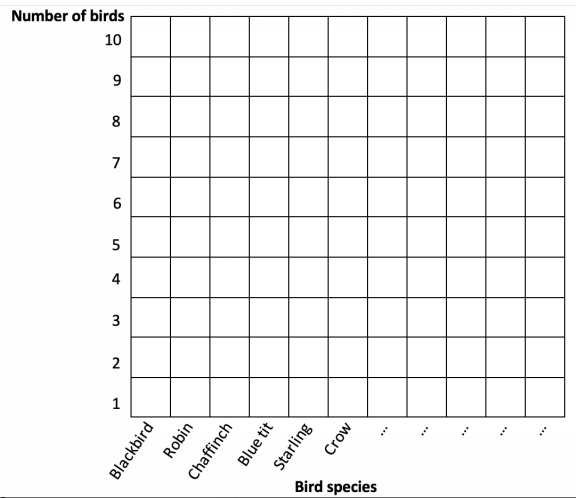
Bird Survey
- Date, time and duration of observation Describe the location:
- Where did you carry out the survey? Your garden, a park…
- What were the surroundings like? In town, near or in woodlands…
- Was there anything to attract birds? A bird feeder, a bird bath…
- Label the horizontal axis of the bar chart with the bird species you saw
- Above the species colour as many squares as you saw birds of this species
INSTRUCTIONS
- Begin by putting out some food for the birds, such as peanuts and sunflower seeds. Make sure you put the food near a tree or shrubs and some place where you can view it safely and quietly. Of course you can also observe the comings and goings at your bird feeder or bird bath. See how to make a bird feeder and bird bath from materials that you have at home on www.livingearth.ie
- Observe for a certain time, e.g. 20 minutes, at different times of the day (morning, lunchtime, evening) and repeat your observation at the same time the following day or days.
- Using the template below count the number of birds that come into your garden, even if they do not feed on the food you put out for them. To help you identify the common garden birds have a look at the guides provided by the National Parks and Wildlife Service and available on www.livingearth.ie
- Now this is where your maths comes in: present your results in a bar chart. A bar chart is a chart that uses rectangle blocks to represent numbers.
- Put the names of the bird species on the horizontal axis (robin, crow, blackbird etc.).
- On the vertical axis mark the frequency, so if you saw 5 blackbirds then you will colour in 5 blocks high.
EXTENSIONS:
Work in a group of bird watchers:
- What birds were more common in places close to beaches, woodlands, open fields or in town?
- Did different people observe the same bird species at the same time of the day?
- Where the more or less birds in one place compare to another at the same time of the day?
Countdown
Friday 15/05/2020
For: Primary & Secondary
The maths activity is a fantastic resource to engage children with mental maths. Recreate the popular TV game show from the comfort of your own home. This game will have contestants using the available numbers and the four standard operations (addition, subtraction, multiplication, and division) to get as close as possible to the target number
What you need:
- Paper
- Pencils
- Timer
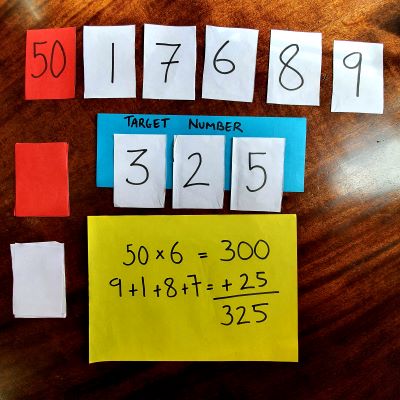
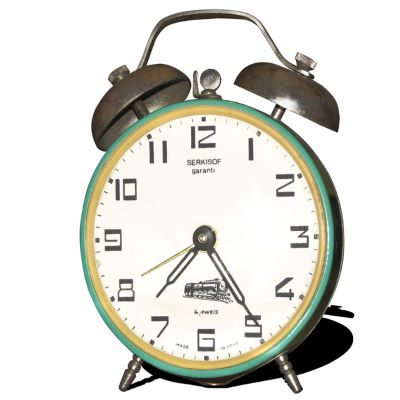
INSTRUCTIONS
The aim of the game is to have the highest total after 20 rounds.
- Students will design the cards that they will use to play this game:
- Shuffle the large number cards and place in a pile face down.
- Shuffle the small number cards and place them in a separate pile face down.
- Students will choose 6 cards and lay them out on the table, facing up. (1 large and 5 small)
- To generate the target number, choose 3 cards from the pile of remaining small cards
- Students must create an equation that gets them as close to the target number as possible, using the basic operations of addition, subtraction, multiplication, and/or division. Each number card can only be used once (It is not necessary to use all the number cards)
- If there is only one player then they can play against the clock – set a timer of 60 seconds. Alternatively, two or more players can play against each other and the first person to reach the target number wins.
- Play 10 rounds.
EXTENSIONS:
Reduce the time limit to 30 seconds
- For an added numeracy challenge – each player should start with 100 points
- After a round, points will be deducted according to how far away from the target number players reached. For example, if they were 2 away from the target number then they would be deducted 2 points
- Play 10 rounds and the player with the highest score wins.
(extension from nrich)
https://www.mathsweek.ie/Maths-at-Home/targetboards/#/registration/Maths-at-Home
Add or Subtract
Thursday 14/05/2020
For: Primary School Children
Today we are sharing a great card came that will have participants practicing their numeracy skills of addition and subtraction.
What you need:
- Deck of cards
- Record Sheet
- Two to four players
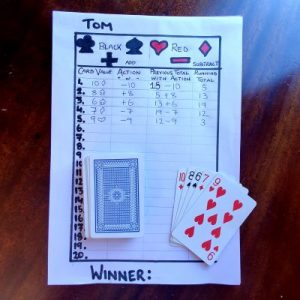
INSTRUCTIONS
The aim of the game is to have the highest total after 20 rounds.
- Design a record sheet for each player.
- Take out the jokers and picture cards from a regular deck of cards and then shuffle the pack. (ACE = 1)
- Each player starts with 15 points.
- Player 1 begins by taking a card from the top of the pack and will add or subtract depending on the value and colour of the card they picked.
- The RED cards require players to SUBTRACT the value shown and the BLACK cards require players to ADD the value shown.
- Players will take it in turns to draw a card and record the calculation and work out their running total.
- Repeat this process until everybody has gone 20 times. (If you run out of cards, then just shuffle the pack again)
- At the end of 20 rounds, the person with the highest total wins!
EXTENSIONS:
The picture cards may be added to the deck by assigning the following values:
Jack = 11
Queen = 12
King = 13
What is the Question?
Wednesday 13/05/2020
For: Young Primary School Children
This quick maths activity can be played many times thorough out the day and will keep young children’s mental maths ticking over.
In a twist of usual events, students will be given the answer to a maths problem and they will have to think of lots of different possibilities for what the question might be, using the basic operations.
What you need:
- Hunt list
- Pencils
- Camera (optional)
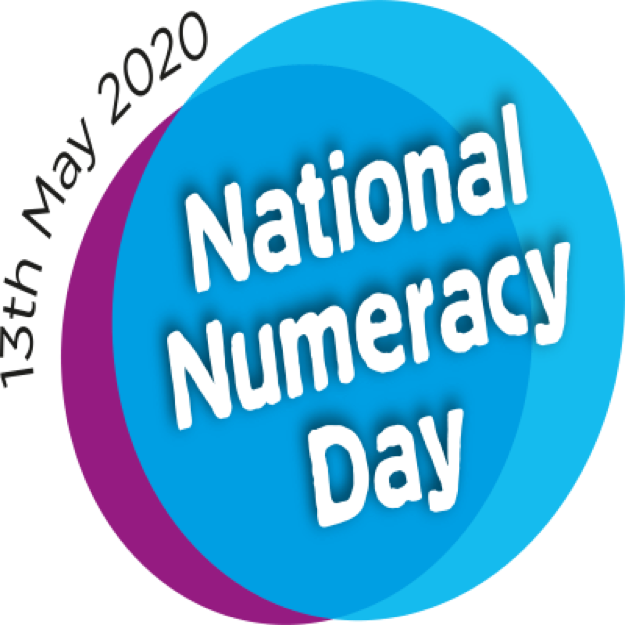
INSTRUCTIONS
- Give pupils any number between one and ten, for example, 6.
- Explain that ’6’ is the answer but you do not know what the question is.
- Ask pupils what the question might have been if it was an addition question?
- What if it was a subtraction question?
- Give pupils the opportunity to come up with lots of different possibilities for what the question might have been using different operations.
Q: What other addition question might it be?
Q: What subtraction question might it be?
Q: Can you think of another one?
Challenge Questions:
Q: Have you found all possibilities? How do you know?
Q: Can you find all possibilities if all the numbers used in the question were less than 20?
Geometry Scavenger Hunt
Tuesday 12/05/2020
For: Primary Pupils
To celebrate the 200th birthday of Irish mathematician John Casey, one of the founders of the modern geometry of the triangle and circle we have devised a geometric scavenger hunt that will have young children searching for 2D in their environment. It is a fun way to help students make connections between the maths they learn in school and maths in real life.
What you need:
- Hunt list
- Pencils
- Camera (optional)
INSTRUCTIONS
Shapes are everywhere! Use this activity sheet to locate a selection of 2D in your home and/or garden. If you cannot get outside to search for these shapes, then you could look through a magazine or newspaper.
- Insert the name of each shape in the space provided, using the bank of key terms below.
- Using the table provided, describe each shape in your own words.
- How many sides does it have?
- How many angles?
- Describe the dimensions of the shape (longer/shorter)
- Locate as many of the shapes as you can in your environment. Count them and record the results
- Take photos of where you see these shapes in the real world. Share your discoveries on social media and use the hashtag #MathsAtHome and tag @MathsWeekIreland
- Leave space at the end to record any irregular shapes that you have discovered.
- Sketch
- Describe the shape
Place Value Battle
Monday 11/05/2020
For: Upper Primary Pupils
This two-player game will have participants thinking logically about where to place the digit cards – the player with the largest number will win the battle.
What you need:
- Paper
- Pencils
- Scissors
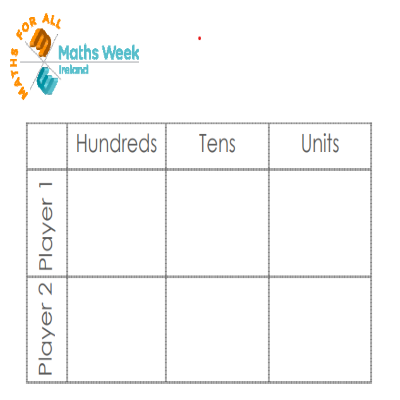
INSTRUCTIONS
What is place value? It is the value of each digit in a number. For example: 365 –
5 is the unit,
6 represents the tens (60)
3 represents the hundreds. (300)
- Design and cut out 10 cards and number them 0 – 9
- Draw a place value grid, like image above.
- Shuffle the cards and place them face down onto a table
- Player one will pick a card at random and then must decide where to place the digit card into their grid
- Player two will then pick a card at random and must decide where to place the digit card into their grid
- Repeat this process until all players have inserted digit cards into the ‘hundreds’, ‘tens’, and ‘units.’
- The person who makes the greatest numbers wins.
Q: Why did you place the ‘2’ there?
Q: If you selected ‘1’ where would you ideally like to place it?
Q: If your opponent selects the ‘9’ first and places it in the thousand’s column can you still beat them? Why / why not?
Q: Your partner has already picked the digit ‘8’ card and placed it in the hundred’s columns – can you still beat them? How?
Sticky Numbers
Friday 08/05/2020
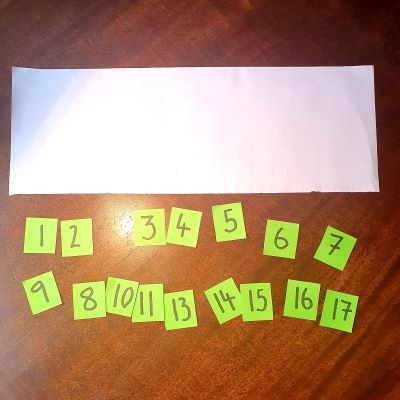
For: Secondary
Can you arrange the numbers 1 to 17 in a row so that each adjacent pair adds up to a square number?
This activity is from the Nrich website and is another great resource for students to practice problem solving. Players will realise the benefits of systematic listing and spotting patterns.
What you need:
- Paper
- Pencils
- Scissors
INSTRUCTIONS
- Cut out 17 cards and label them 1 to 17
- Arrange the cards in a row so that each adjacent pair adds up to a square number
- For example, 1, 3, 13, 12, …
1 + 3 = 4
3 + 13 = 16
13 + 12 = 25
A ‘perfect square’ is the result of multiplying a number by itself. The first 5 square numbers are 1,4,9,16,25 and are obtained by squaring the first 5 counting numbers:
| Square numbers: | 1, | 4, | 9, | 16, | 25 |
| 1² | 2² | 3² | 4² | 5² | |
| Obtained by: | 1×1 | 2×2 | 3×3 | 4×4 | 5×5 |
Create a systematic list to find all pairs of numbers from 1 to 17 that sum to square numbers.
| Pairs involving 1: | Square: |
| 1 + 3
1 + 8 1 + 15 |
= 4
= 9 = 16 |
| Pairs involving 2 | Square: |
| 2 + 7
2 + 14 |
= 9
= 16 |
| .
. . |
|
| 16 + 9 | = 25 |
| 17 + 8 | = 25 |
Q: What do you notice about pairs involving 16 and 17?
(16 and 17 only produce one possible pair each.)
Q: Where should 16 and 17 be placed in the row?
(At both ends)
Once you have placed a number into the row, refer to your list and cross out each pairing where it appears.
If you get stuck, see can you spot a pattern with the square numbers obtained
25, 16, 9, 16, 25, 16, 9, 16, …
Magic Squares
Thursday 07/05/2020
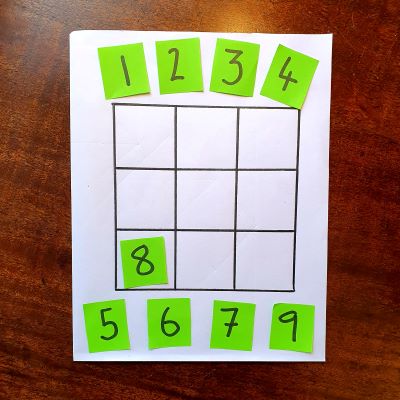
For: Upper Primary and Secondary
A magic square is square grid with special arrangements of numbers in them.
Today’s maths activity involves placing the first 9 counting numbers into a 3 x 3 grid so that each row, column, and diagonal add up to the same total.
This type of recreational maths is a lovely example of the beauty and wonder of numbers. Magic squares are both simple and yet subtly complex:
“A magic square is like a numerical mantra, an object of endless contemplation and a self-contained expression of order in a disordered world” wrote Alex Bellos in his fascinating book Alex’s Adventures in Numberland – Dispatches from the wonderful world of mathematics.
What you need:
- Paper
- Pencils
- Scissors
INSTRUCTIONS
- Draw and cut out the numbers from 1 to 9 on 9 cards
- Draw a 3 x 3 square grid
- Place the numbered cards into the grid so that the sum of each row, column and diagonal is equal to the same target number
- Can you figure out a suitable target number?
HINT 1:
The sum of each row, column and diagonal should add up to a target number of 15
HINT 2:
Place the number 5 into the middle box
HINT 3:
Put the even numbers into the corners
Try placing the odd numbers in the corners and
Towers of Hanoi
Wednesday 06/05/2020
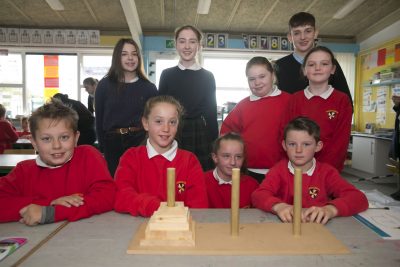
For: primary and secondary
The Towers of Hanoi is a well-known “ancient” puzzle. It can be played as just a game but also offers great learning in problem solving skills.
What you need:
- Towers of Hanoi
The classic Towers of Hanoi puzzle uses three posts and five disks of different sizes. You may have such an arrangement in your home as these are popular toys for toddlers helping develop motor skills and coordination. If not, you can improvise. In these difficult times, you may not have all the material suggested. You may need to adapt these activities to suit your needs and materials available. Maybe your kids could think of ways of adapting and improvising. This is valuable skills development. See some hints below. Please share your pics of your home-made Towers of Hanoi by twitter @mathsweek, facebook @mathsweek Instagram: mathsireland email: mathsweek@wit.ie
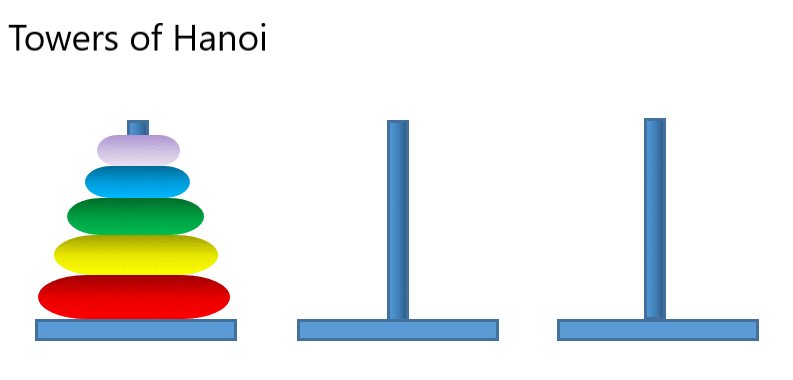
Towers of Hanoi: method and extension activities
INSTRUCTIONS
The Towers of Hanoi challenge is to move 5 rings from the left hand post to the right hand post following particular rules:
- A move consist of taking one ring and moving it onto another post.
- You cannot place a larger ring on top of a smaller one.
You can take as many moves as you like. Eventually you will manage to move them all. That may be fine for younger children, but older children should be looking for a pattern or system to solve it.
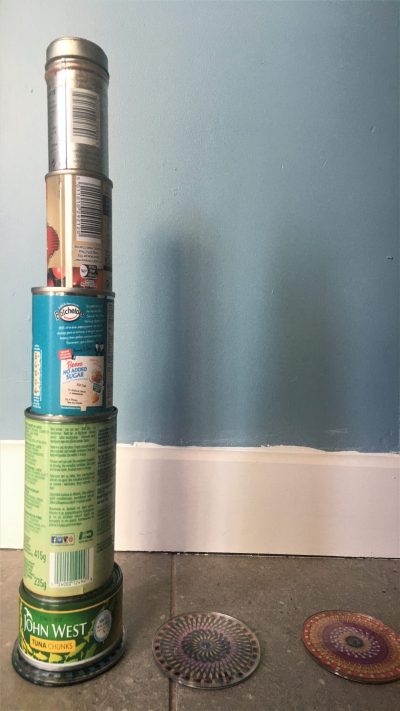
IMPROVISE
- Towers of Hanoi can be improvised in many ways. You don’t even need 3 posts, just make place markers for the three positions.
- You could use coins, boxes, books, lego, any sorts of safe items in the home.
- You don’t even need 5 different size items, you could number them and say you cant put a larger number on a smaller one.
Coin Puzzles
Tuesday 05/05/2020
For: upper primary and secondary
Coin Puzzles are a popular type of recreational maths that like the matchstick puzzles develop a student’s logic and reasoning skills. This type of hands-on problem encourages participants to get stuck in and make mistakes without fear of failure or looking silly. These problems are designed so that the solution is not immediately obvious, you might try the following strategies:
- Strategy 1: trial and error is a must. Try to be smart – dont do the same thing again and again. Discuss the reasons why something did not work.
- Strategy 2: Can you simplify the problem? Use less coins?
- Strategy 3: Construct the answer alongside and aim at that. Look for similarities and differences.
- Strategy 4: Change your point of view. Look at it from a different angle.
What you need:
- 10 coins or counters
In these difficult times, you may not have all the material suggested. You may need to adapt these activities to suit your needs and materials available. Maybe your kids could think of ways of adapting and improvising. This is valuable skills development.

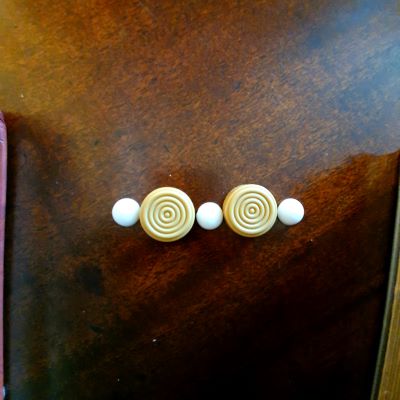
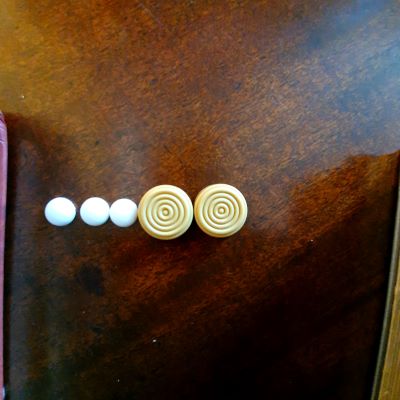


What is the Rule?
Monday 04/05/2020
For: 12-16 years, Secondary
Can you figure out this hidden mathematical operation? This quick activity is a great one to practice algebra, functions and problem solving.
What you need:
- Pen
- Paper
In these difficult times, you may not have all the material suggested. You may need to adapt these activities to suit your needs and materials available. Maybe your kids could think of ways of adapting and improvising. This is valuable skills development.
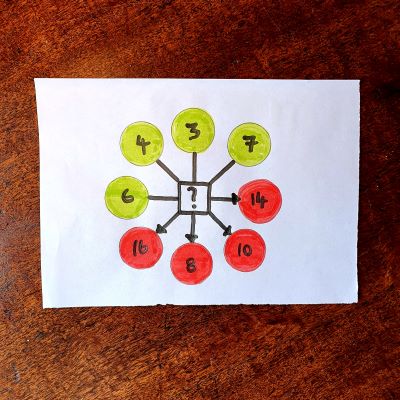
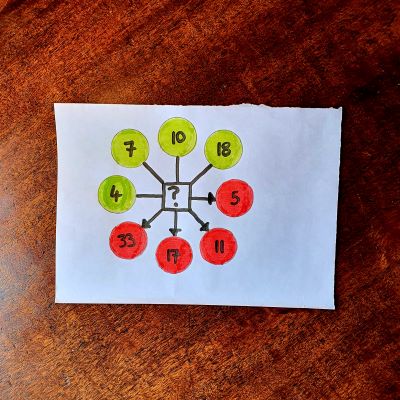
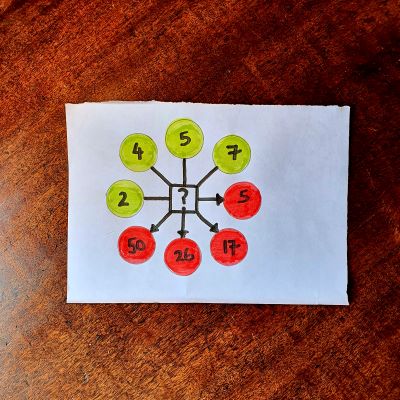
Encourage students to discuss their thinking and to justify their reasoning. Encourage students to discuss their thinking and to justify their reasoning.
INSTRUCTIONS
A function is a rule that describes the relationship between an input number and an output number.
For example, if I had a function where the rule was to multiply the input by 3, then the first 4 counting numbers would result in the following outputs:
| Input | Rule: Multiply by 3 | Output |
| 1 | 1 x 3 | 3 |
| 2 | 2 x 3 | 6 |
| 3 | 3 x 3 | 9 |
| 4 | 4 x 3 | 12 |
Using the operations addition, subtraction, multiplication and/or division, can you work out what is going on in the centre box of each drawing?
What is the rule for converting the input number to the output?
- Can you explain it in your own words?
- Can you use algebra to explain it?
For example, in Diagram 1, what operations could convert 6 to 14, and 4 to 10 and 3 to 8, and 7 to 16?
Diagram 2:
What is the rule that coverts 4 to 5, and 7 to 11, and 10 to 17, and 18 to 33?
Mathstick Puzzles
Friday 01/05/2020
For: Upper Primary and Secondary
Matchstick Problems are a great activity to develop critical thinking and problem solving.
Of course, matchsticks are not suitable for young children so swap them for other materials lying around the house
What you need:
Matchsticks or toothpicks (straws or a selection of any sticks of equal length)
In these difficult times, you may not have all the material suggested. You may need to adapt these activities to suit your needs and materials available. Maybe your kids could think of ways of adapting and improvising. This is valuable skills development.
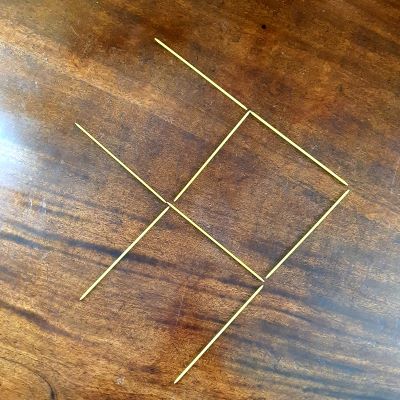
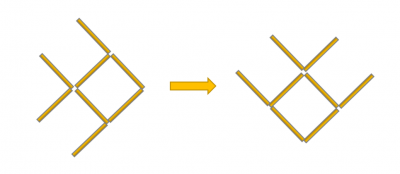
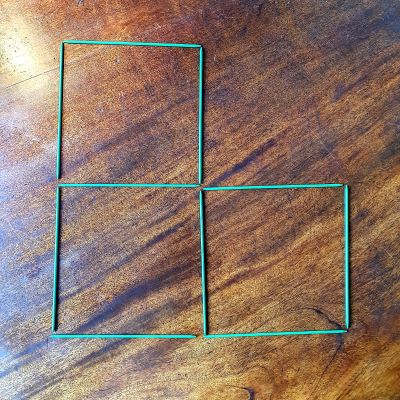
Crossing the River
For: Family
Thursday 30/04/2020

This fun activity will have all the family using logic and reasoning skills to get the farmer and his animals safely across the river!
This puzzle offers a great opportunity to discuss problem solving strategies:
- Observe & Wonder
- Trial & error
- Recap & Plan
- Check & Justify
WHAT YOU WILL NEED
- Toys
- Arts and crafts materials
- Camera
Recreate this classic maths problem with materials from your home.
Please post photos of your creations and solutions using any of the channels below:
INSTRUCTIONS
This is a very famous and tricky puzzle. It can be difficult to figure out, but if you create the puzzle with items that you can move, the puzzle may become easier. You can use toys for the farmer, fox, goose and grain. Otherwise you can draw pictures of each and cut them out.
A farmer must transport a fox, a goose, and some grain across a river. He/She has a boat which can only carry him/her and one other thing. If the farmer is not present, the fox will eat the goose. If the goose and the grain are left together alone, the goose will eat the grain.
Help the farmer cross the river.
How can she/he transport everything across the river?
How many trips will it take?
Use toys and other objects to represent the farmer, fox, goose and grain. And make or use something to represent the boat and the river.
Allow your children to use their imaginations and creativity.
Then you can try different ideas: put the items in the boat and bring them across the river in turn, If you have two items that shouldn’t be left together you can simply start again. It is ok to try different moves at random but if you are not making progress, you need to reflect on what you are doing that is not working. Make sure to try a different way the next time.
Two Primes Make a Square
For: Upper Primary to Junior Cycle and KS3
Wednesday 29/04/2020

Can you make square numbers by adding two prime numbers together?
This Nrich activity will have children practicing their problem-solving skills as well as broadening and developing their maths vocab.
There are multiple ways to attempt this problem, plenty of opportunity for participants to discuss their approaches and strategies.
What you will need:
- Paper
- Pencils
INSTRUCTIONS
- Can you make square numbers by adding two prime numbers together?
- Allow the student to ask questions and define what “prime number” and “square number” mean.
- Give them an example of the sum of two primes resulting in a square number: 2 + 2 = 4
- Try with the square numbers from 4 to 20.
A prime number is a number that only has two factors: itself and one. The prime numbers between 0 and 20 are:
2,3,5,7,11,13,17,19
A ‘perfect square’ is the result of multiplying a number by itself. The first 5 square numbers are 1,4,9,16,25 and are obtained by squaring the first 5 counting numbers:
| Square numbers: | 1, | 4, | 9, | 16, | 25 |
| 1² | 2² | 3² | 4² | 5² | |
| Obtained by: | 1×1 | 2×2 | 3×3 | 4×4 | 5×5 |
- Once the students have spent some time coming up with ideas on how they will go about solving this problem, they should share their ideas and discuss which strategies they like best.
A Triangle with a Difference
For: Upper Primary to Junior Cycle and KS3
Tuesday 28/04/20
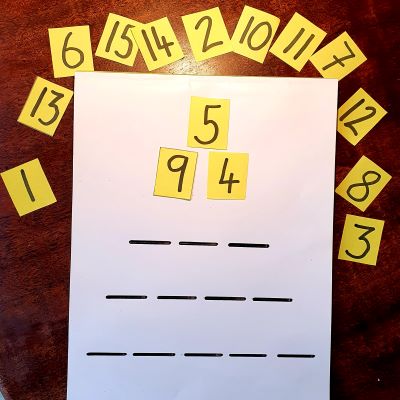
This card game involving subtraction will have participants develop their problem-solving strategies. Place the numbers 1 to 15 into a triangle so that each card is the difference between the two cards immediately below it.
What you will need:
- Cards
- Pencils
In these difficult times, you may not have all the material suggested. You may need to adapt these activities to suit your needs and materials available. For instance, you could draw out the cards. Maybe your kids could think of ways of adapting and improvising. This is valuable skills development.
INSTRUCTIONS
- Cut out 15 cards and label them 1 to 15
- Insert the cards into a triangle format, with 5 rows.
- The first row will have 1 card,
- The second row will have 2 cards,
- 3rd row will have 3, etc.
- Place the numbers 1 to 15 into a triangle so that each card is the difference between the two cards immediately below it, to left and right.
- The first three cards have been done for you. 5 is the difference between 9 and 4. (9 – 4 = 5)
- Discuss strategies.
- 15 must go in which row? Why?
Simplify:
Use less cards. Use six cards (1 to 6) and arrange them into three rows using the rules above.
Making Shapes
For: primary school students
Monday 27/04/20
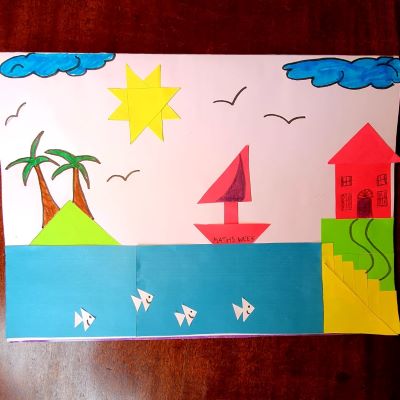
This maths and crafts activity will help children become more familiar with shapes and symmetry.
What you will need:
- Coloured Paper
- A3 Paper
- Ruler
- pencil
- Scissors
- Colours
- Glue stick
In these difficult times, you may not have all the material suggested. You may need to adapt these activities to suit your needs and materials available. For instance, you could draw out the cards. Maybe your kids could think of ways of adapting and improvising. This is valuable skills development.
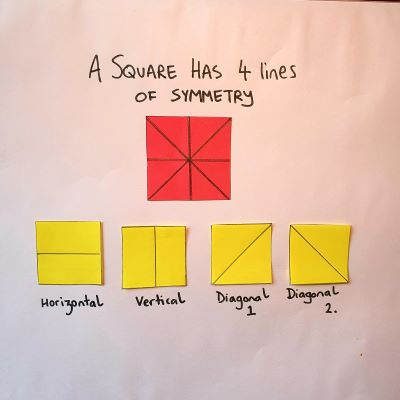
INSTRUCTIONS
- Draw several squares of different sizes on coloured paper and then cut them out. Compare the different sizes and colours. (bigger, smaller, blue, green, longer/shorter sides)
- Discuss the properties of a square.
- How many sides?
- How many corners?
- What do you notice about the lengths of the sides?
- (4 equal sides, 4 corners, 4 right angles)
- Discuss the lines of symmetry on a square – a shape has symmetry if a central dividing line can be drawn on it, that shows that both sides of the shape are the same. Sometimes it’s referred to as mirror symmetry.
- Get the child to fold the shape along the different lines of symmetry so that they can be clear that the two sides are identical.
- How many different lines of symmetry can they find?
- A square has four lines of symmetry as shown in picture.
- Cut some/all the squares, along their lines of symmetry to form smaller triangles and rectangles.
- Children will arrange the shapes to create a piece of art.
You can do more activity with shapes and symmetry with our polyomino activity
Dastardly Diagrams
For: Upper primary school and secondary school students
Friday 24/04/20
Develop problem solving strategies with this popular maths activity.
What you will need:
- Pencils
- Paper
In these difficult times, you may not have all the material suggested. You may need to adapt these activities to suit your needs and materials available. For instance, you could draw out the cards. Maybe your kids could think of ways of adapting and improvising. This is valuable skills development.
Activity 1:
Try to draw these shapes without lifting your pen off the page and without tracing over any edge more than once.
Can it be done?
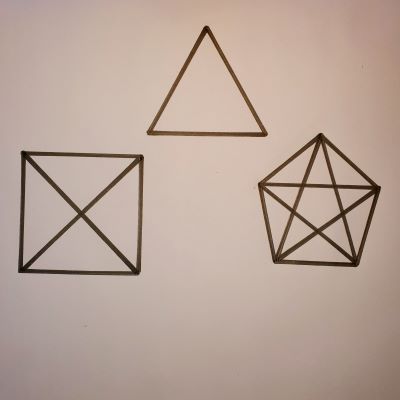
Activity 2:
Guess whether you can draw the following shapes without lifting your pen?
Then check your guess and see if you were right!
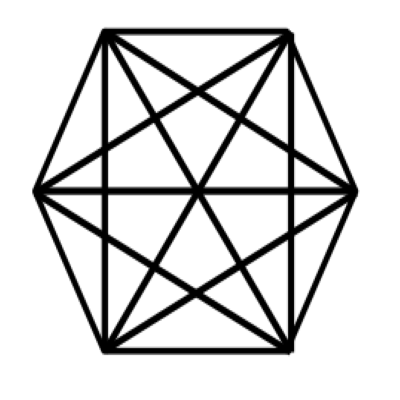
Activity 3:
The following shape can be drawn, but only if you begin at certain points.
Try it for yourself. Which points can you start from, and draw the shape? And which points can you not start from?
Can you explain why?
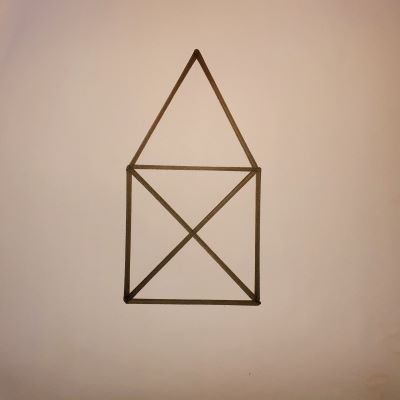
Activity 4:
For each of the following diagrams, decide which category they fall into:
- You can’t draw them without lifting your pen
- You can draw them, but you must start a certain point
You can draw them, starting at any point.
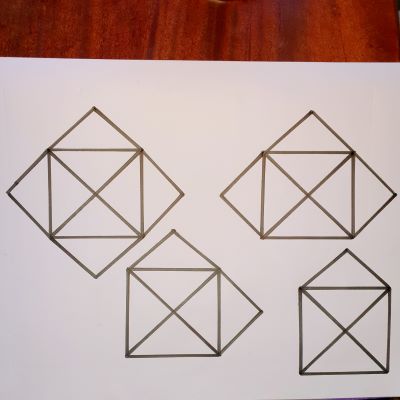
These activities belong to an area of maths called graph theory and are from the Irish Maths Circles resources. To learn more about Irish Maths Circles and check the solution handbook see here
Mathematical Thinking in the Garden
For: Upper Primary and Junior Cycle Pupil
Thursday 23/04/20
Type of Maths involved: Measure, Statistics, Probability, Geometry, Trigonometry, Exploring, questioning, working systematically, visualising, conjecturing, explaining, generalising, justifying, proving
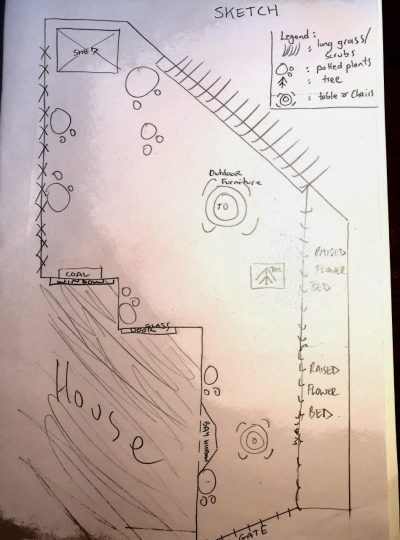
PART 1. MEASUREMENT
This activity will see children using problem solving strategies to create a scaled map of their garden. If you don’t have a garden, then adjust the activity to create a scaled diagram of the floor plan of your home.
Children will practice the skills that they have learned in the classroom and apply them to their world. They will observe their surroundings and then select and use appropriate techniques to complete this task. Children will make estimates, then accurately measure the dimensions of the garden and present the project as a scaled map, inclusive of symbols.
Children should be prompted to ask questions and make assumptions – qualities of a great mathematician!
“By asking What do you notice? What do you wonder? we give students opportunities to see problems in big-picture ways, and discover multiple strategies for tackling a problem. Self-confidence, reflective skills, and engagement soar, and students discover that the goal is not to be “over and done,” but to realize the many different ways to approach problems.” Anthony Persico, Mash up Maths
During problem solving, children should be encouraged to communicate their mathematics and explain their reasoning in written and verbal form.
Get the child to explore their garden, ask “what do you notice?” Take note of the shapes and the materials (natural & human made).
- Ask your child “what do you wonder?” Children may have to make assumptions or find out more information by asking questions (questions may arise about slopes, angles, difficult to measure overgrown sections, curved areas, etc. Agree on assumptions that should be made)
- Get them to draw a neat sketch of the garden, from a bird’s eye view. (This will be a rough draft; a more accurate scaled map will be drawn later). Include all the relevant sections – the grass patch, pond, flower bed etc.
- Discuss the dimensions of the garden. What is the shortest side? Estimate the length. Then discuss what instruments they could use to measure it accurately.
- Grab a measuring tape, allow the child to study it in detail and decide on a unit of length. In Ireland and Britain, we officially use the metric system: kilometres, metres, centimetres, millimetres etc.
- Measure the length of the garden. Make sure the tape is lying flat on the ground and held taut. (measure twice, record once)
- Record the results into a table and/or the sketch diagram. Don’t forget to include the unit: metres and centimetres.
- Repeat the process for the other dimensions in the garden, including all the pavements, lawns, bushes, flower beds, ponds etc.
- Calculate the area of the garden. If your garden is a rectangle then this will be very straight forward – you multiply the length x width. If your garden is an irregular shape, for example an L shape, then they should divide it into regular shapes such as two rectangles. Get the area of both rectangles and add them together (****diagram here, show metres squared)
- What proportion of the garden is the lawn? Measure the area of the lawn and divide your answer by the area of the entire garden.
What you will need:
- Pencils
- Paper
- Measuring Tape
- Ruler
In these difficult times, you may not have all the material suggested. You may need to adapt these activities to suit your needs and materials available. For instance, you could draw out the cards. Maybe your kids could think of ways of adapting and improvising. This is valuable skills development.
By bringing maths into everyday experiences, like investigating the dimensions of the garden/house, students practice what they have learned in school and apply it in a meaningful way. This type of activity will deepen their understanding of mathematical concepts as well contribute positively to their wellbeing. It is also a great opportunity to develop problem-solving and reasoning skills. It doesn’t matter if you are unfamiliar with the methods they are using or if a child doesn’t reach an end point, getting stuck is to be expected. Try to figure out the problem together, facilitate a discussion about what they have done so far and where they aim to end up. Communicating mathematically in this way offers a very worthwhile learning experience. Talk to your child about having a growth mindset, praise hard work and resilience instead of speed and intelligence.
PART 2 SCALE DRAWING
Now that you have a sketch of the garden drawn it’s time to begin the scale drawing.
Scale diagrams are often used to represent larger objects (or smaller objects) on a page. This type of maths is used in lots of different professions such as architects, engineers, construction workers, gardeners and cartographers (map drawers). Secondary school students practice scale drawings in many different subjects including geography, technical drawing, construction work and of course in the maths class too, when they are studying ratios.
A ratio is a way of comparing the sizes of two or more quantities. The mathematical symbol for ratios is a colon (:)
Instructions:
- A scale of 1:50 means that every 1 cm on the page is equal to 50 cm on the ground.
- Begin by converting all the measurements taken from the garden into the measurements needed for the page.
You do this by dividing by 50 cm (or 0.5 if you’re using metres)
Example the wall measured 330cm
330 cm / 50 cm = 6.6 cm
so to represent the wall that actually measures 330 cm in length, I will draw a line on the page that is 6.6 cm in length.
- Put the results from step 2 into a table
- Using a ruler begin the scaled diagram by drawing the house wall boundary – you are sure that this wall is straight.
- You may use a protractor (or a ruler) to create perpendicular lines from the house wall.
- Continue until the perimeter of the garden has been drawn and then include the internal features such as lawns, ponds, decking etc.
- Include any relevant features, using symbols. Trees, Bushes, flower beds, flowerpots, furniture, BBQs.
- Draw a legend somewhere on the page which will explain what each symbol on the diagram represents.
EARTH DAY: Mathematical Nature Scavenger Hunt
For: Primary Children
Wednesday 22/04/20
This cross-curricular fun activity celebrates EARTH DAY today. It is great way to get children excited about maths and nature. Children will have to look for certain materials found in nature, count them, record their results and communicate their mathematical thinking. By bringing maths into everyday experiences, like exploring in the garden, children can practice their mathematical skills in a meaningful way. This type of activity will deepen their understanding of mathematical concepts as well contribute positively to their wellbeing.

Search for as many of the following items as possible
Fallen leaves:
- How many fallen leaves can you find?
- Collect some samples of different types of leaves – try get as many different shapes as possible
- Draw a sketch of one of the leaves or make a leaf rubbing
- What type of shape does it have?
- What colour is it?
- How would you describe the texture of the leaf? (waxy/smooth/rough/flimsy/bumpy/crumbly)
Sticks
- How many sticks can you find on the ground?
- Can you collect 10 sticks?
- Which stick is the longest/shortest/thinnest/thickest?
- How would you describe the texture? (smooth/rough/bumpy/hard/crumbly)
- Arrange the sticks in the row, anyway you like/from smallest to biggest
Feathers
- Can you find any feathers on the ground?
- How many can you collect?
- Which feather is the longest/shortest/biggest/smallest?
- Can you draw a sketch of a feather?
- What colour is it?
Flowers
- How many white/pink/yellow/purple flowers can you see?
- Can you find a flower with 2 petals/3petals/4petals/5petals/many petals? count how many you find and record the results
Animals
- Can you find an animal with 0 legs/ 2 legs/4 legs/ more than four legs?
- Record how many of each differen birds you see in your garden. Put a time limit on it.
- Can you find a group of animals together? Birds/insects/cattle/fish? How many?
- Sort the animals in order of size – draw a picture
- Which is the biggest/smallest/fastest/slowest/heaviest/lightest
- Which is the odd one out? Seagull, Robin, blackbird, cat? Cat, dog, butterfly, cow?
Trees
- How many trees can you see?
- Do they have leaves or not?
- How to the tree differ from one another? What are the differences? Similarities?
- If they have leaves, what colour are they?
- Estimate the number the branches/leaves? Is it possible to count?
- How would you describe the tree? (tall/small/wide/thin/bushy/bare)
- Categorize the trees in terms of size – which one is the tallest/shortest? Which has the thinnest trunk?
- Are there any animals in the tree? Count them
- Take a bark rubbing. How would you describe the texture/colour of the bark?
Human made objects:
- What types of objects can you see in your garden that are not natural?
- How would you describe the shape?
- Can you find an object that you think is heavier that this?
Can you find the following shapes?
- straight line,
- curved line,
- square,
- triangle,
- circle,
- cuboid,
- sphere
Patterns and symmetry
- Can you find any interesting repeating patterns?
- Predict what would come next in the pattern if it were to continue
- Can you create your own repeating pattern with some of the materials you collected?
- Can you find something that has 1 line of symmetry? 2 lines of symmetry? Rotational symmetry?
What you will need:
- Pencils
- Hunt list
- Clock
In these difficult times, you may not have all the material suggested. You may need to adapt these activities to suit your needs and materials available. For instance, you could draw out the cards. Maybe your kids could think of ways of adapting and improvising. This is valuable skills development.
INSTRUCTIONS
Create a list before you head out, choose as many items as you like. Check out our template below for ideas. Children may like to be involved in this process – brainstorm what natural materials and wildlife you expect/hope to find in the garden.
As an extra challenge you could extend the scavenger hunt to another location and then add the two together. For example, the front garden and the back garden or the local park and the beach.
Children may like to collect some samples (10 – 20) for an art activity later. Please be considerate of the natural environment and only gather objects that have already fallen to the ground.
How to Play:
- Once you have devised a list, take note of the time on the clock, and then head outside.
- Begin by looking for the first object on your list. Count how many of those items you see. For example, there are 3 trees in the back garden
- Write down that number. Or if there are lots of those items it may be a good idea to keep a tally instead (just put marks on a piece of paper but the 5th mark is drawn across the previous 4 marks (see below)
- You may wish to collect some of the natural items for further analysis later (between 10 and 20 items) e.g. sticks, round pebbles, fallen leaves, blades of grass, flower petals, shells)
- Continue through the list, searching for each of the items. Record how many of each kind you find. Take some sketches, tree rubbings or photographs.
- Don’t forget to take your time and look around – you may see some other interesting items that weren’t on your list. What other maths can you see around you?
- When you’re done, look at the results. Which natural item did you find the most of? The least? Which stick is the longest/shortest/thickest/thinnest etc.
- Record the time on the clock again. How long did you spend scavenging?


Close call
For: Primary Children
Tuesday 21/04/20
This 2-player game is great for practice mental arithmetic and addition of two digit numbers.
Participants will practice their problem solving skills as they have to really think about which cards to choose and what numbers to make with them.
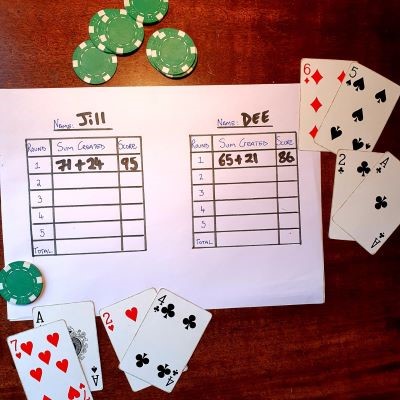
This activity is popular in schools and we don’t know the origin.
What you will need:
- Pack of playing cards
- Results table
- Pencils
- Counters
In these difficult times, you may not have all the material suggested. You may need to adapt these activities to suit your needs and materials available. For instance, you could draw out the cards. Maybe your kids could think of ways of adapting and improvising. This is valuable skills development.
INSTRUCTIONS
The aim of the game is to get the highest total by coming closer to the target number than your opponent.
- Take all the tens and picture cards out of the deck of cards – they will not be needed. Ace = 1, Joker = 0
- Shuffle the deck and deal each player 6 cards
- Each player must then select 4 of the cards and use them to create two 2-digit numbers.
- The objective is to create two numbers that when added together come as close to 100 as possible, without going over.
- The person who is closest to 100 wins the round and gains one counter. If there is a tie, then each player receives a counter.
- Each player must record their sums on the score sheet.
- The player with the most counters at the end of 5 rounds wins
- Double check each other’s work by adding up all the scores and put the answer in the total row.
Monster Calculations
For: Primary Children
Monday 20/04/20
There are many versions of this game that develop mental arithmetic but this is a great fun version that you can make and play at home. The object of the game is to reach 20 points by adding a series of cards drawn randomly out of a bag but watch out for the monster cards because they will wipe you out!
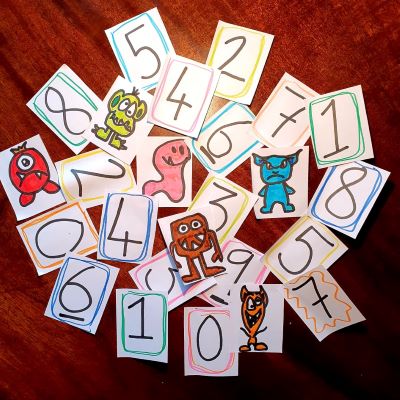
This activity was presented as part of an EU Comenius-School Partnership 2011-2013: Living Maths by the Kaethe-Kollwitz-School Giessen Germany
PIG Game
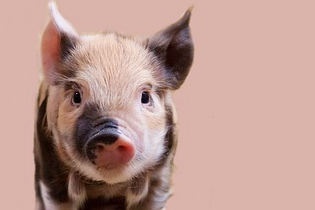
Pig is an alternative game to practice arithmetic using dice. We also have an online version too. See here for more
What you will need:
- Paper
- Pencils
- Colours
- Bag
- Counters
In these difficult times, you may not have all the material suggested. You may need to adapt these activities to suit your needs and materials available. For instance, you could draw out the cards. Maybe your kids could think of ways of adapting and improvising. This is valuable skills development.
INSTRUCTIONS
The object of the game is to get 20 points in one round (but not more than twenty). To achieve this objective, the players will pick a card from the bag, if it is a number, they add it to their running total. They may choose to bank this total or they may decide to draw another card. However, if a player draws a monster card, they lose their turn and their points!
So, a player must decide after every draw if he/she runs the risk and draws another card or if he/she stops and keeps the points.1. To begin the children will design the cards that they will be playing with. Cut out about 40 cards or use post-it notes or flash cards.
- To begin the children will design the cards that they will be playing with. Cut out about 40 cards or use post-it notes or flash cards.
- 30 of the cards will have the numbers 0 to 9 on them and 10 of the cards will have drawings of monsters on them.
- Player one will begin by drawing a random card from the bag. If his/her first card is a number, the player can draw a second card.
- If this card is a number too, the player must add the number to the first one.
- The player can draw a third, fourth, fifth… card too. But if he/she draws a monster card, all their points are lost (0 points). If a player gets a total that is more than 20 then all their points are lost too.
- Then it is player 2’s turn. He/she knows the result of the first player and can stop when he/she has more points than player 1.
- At the end of the round the players add up their numbers, the player who has achieved the highest total will receive a chip/counter/pebble. First to collect 10 counters wins.
- Players take it in turns to begin each round. In round 2, player 1 becomes player 2 etc.
Magic Card Trick
For: All the Family
Wednesday 08/04/20
Use this algorithm to wow you family and practice your problem-solving skills to figure out the why the trick always works. Try doing it online with your friends.
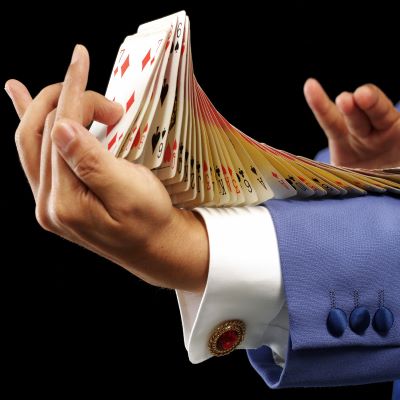
What you will need:
- 9 cards from a pack of playing cards
In these difficult times, you may not have all the material suggested. You may need to adapt these activities to suit your needs and materials available. For instance, you could draw out the cards. Maybe your kids could think of ways of adapting and improvising. This is valuable skills development.
INSTRUCTIONS
- Shuffle the pack of cards
- Deal out 3 piles, each containing 3 cards (9 cards in total)
- Get your friend to choose one of the piles
- Show your friend the bottom card from the chosen pile of cards (make sure you can’t see it) For example Two of Clubs
- Now you are going to stack your three piles together, ensuring that you put the pile that your friend has chosen on top
- Ask your friend to lie about the card that they had seen. They are to choose from any of the other 51 cards from the deck. For example, they may say three of diamonds.
- You will spell out the number they choose from step 6, starting with the top card. For example, spell out T H R E E and place 5 cards on the table, face down.
- Pick those cards up (for example the 5 cards which spell three) and put them under the pack.
- Then spell out O F (place 2 cards down on the table)
- Pick up the two cards and place them under the pack
- Then spell out the suit, for example D I A M O N D S by placing those cards on the table face down.
- Again, pick up those cards and place them under the pack.
- Then spell out F A L S E and reveal the 5th card, the E – this should be their card!
3 in a Row
For: Primary
Tuesday 07/04/20
A mathematical twist on the game BINGO, where participants practice their maths skills of counting, addition and subtraction.
There is free access to newspapers (including Independent, Times and Examiner) and magazines (including science and history ones) through the libraries here. You must sign in with library card number. If you dont have a library card you can sign up online for access to services during Covid-19 closures see here.
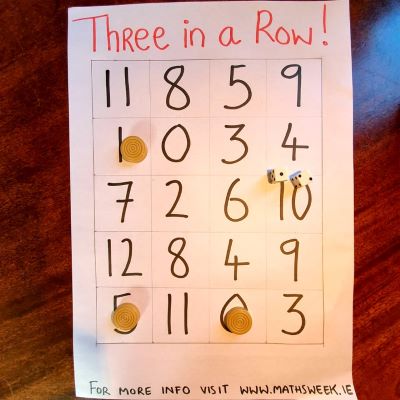
What you will need:
- Number grid per pupil. Draw it or download from the link below.
- A pair of dice (apps available online)
- Counters
In these difficult times, you may not have all the material suggested. You may need to adapt these activities to suit your needs and materials available. For instance, you could use pieces of lego as counters. You can draw out the grid if you don’t want to print out the template. Maybe your kids could think of ways of adapting and improvising. This is valuable skills development.
INSTRUCTIONS
- Give each player a number grid, two dice and some counters.
- Players take it in turns to throw the two dice. They must then decide if they will add or subtract using the two numbers.
- If their answer appears on the grid, they can cover it with a counter.
- The first person to cover three numbers in a row (vertically, horizontally or diagonally) is the winner
Questions:
- What does vertical/horizontal/diagonal mean? Show me using the grid.
- Why did you subtract the two numbers?
- What could have happened if you added instead?
- What’s the highest number you can get while playing?
- What’s the lowest?
- Do you have a plan while playing?
- Would it be important to have a plan? Why?
- Why did no one win in that game? (For example, the other person blocked my path).
- Now that you’ve played it once what might you do differently the next time?
Flower Petal Addition
For: Primary (5 – 7 yo)
Monday 06/04/20
This colourful Maths and Crafts activity will help young students with their mathematical fluency, using the numbers 1 to 10.
From the creators of Fantastic Fun and Learning and Preschool Teacher 101.
There is free access to newspapers (including Independent, Times and Examiner) and magazines (including science and history ones) through the libraries here. You must sign in with library card number. If you dont have a library card you can sign up online for access to services during Covid-19 closures see here.
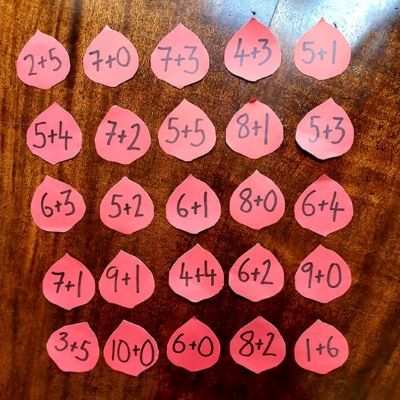
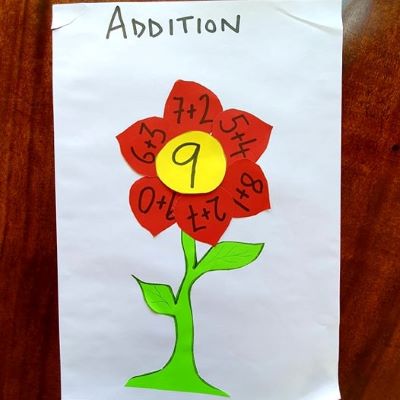
Find lots more activities like this at https://www.fantasticfunandlearning.com/
What you will need:
- A3 blank Paper
- Coloured paper
- Markers or Colours
- Scissors
In these difficult times, you may not have all the material suggested. You may need to adapt these activities to suit your needs and materials available. For instance, you could stick two sheets of A4 together to make an A3 sheet. Maybe your kids could think of ways of adapting and improvising. This is valuable skills development.
INSTRUCTIONS
- Draw 5 large flower stems and centres on coloured card or use blank paper and get the child to colour it in.
- Draw the number 6 onto the centre of the first flower, then insert the numbers 7,8,9,10 onto the remaining four flower centres.
- Draw and cut out 30 different flower petals.
- Insert the following sums on individual petals:
| 6 + 0 | 7 + 0 | 8 + 0 | 9 + 0 | 10 + 0 |
| 5 + 1 | 6 + 1 | 7 + 1 | 8 + 1 | 9 + 1 |
| 4 + 2 | 5 + 2 | 6 + 2 | 7 + 2 | 8 + 2 |
| 3 + 3 | 4 + 3 | 5 + 3 | 6 + 3 | 7 + 3 |
| 2 + 4 | 2 + 5 | 4 + 4 | 5 + 4 | 6 + 4 |
| 1 + 5 | 1 + 6 | 3 + 5 | 2 + 7 | 5 + 5 |
5. Children should match the flower petal to the appropriate stem
Maths Media Poster
For: Primary
Friday 03/04/20
This activity explores how important maths is in the “grown-up” world. It involves a search for numbers in papers, magazines etc. You can also use on-line resources or even the TV. This is a valuable learning exercise even if you don’t get to make an actual poster.
There is free access to newspapers (including Independent, Times and Examiner) and magazines (including science and history ones) through the libraries here. You must sign in with library card number. If you dont have a library card you can sign up online for access to services during Covid-19 closures see here.
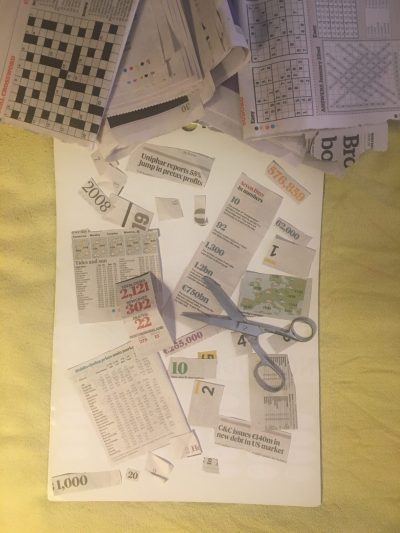
What you will need:
- Magazines, newspapers, brochures etc.
- Scissors
- A3 paper
- Glue Stick or equivalent
In these difficult times, you may not have all the material suggested. You may need to adapt these activities to suit your needs and materials available. Maybe your kids could think of ways of adapting and improvising. This is valuable skills development.
Be aware that a lot of numbers in the media at present are about Covid-19. If this is sensitive for your children then you may have catalogues from supermarkets etc. to use instead or go online or use TV ads.
INSTRUCTIONS
- Search for the numbers from 1 to 100 throughout the paper (use page numbers, dates, advertisements, sports statistics etc)
If you do have materials for the poster
- Cut out the numbers
- Paste them in sequence on an A3 sheet of paper (or equivalent)
Ask these questions of the children when they are playing:
- In its original place, what does the number refer to? Is is a date, time, quantity, price, age, score, numbering on a list?
Snakes and Ladders
For: Pre-school and Primary. Also a game all the family can play
Thursday 2/04/20
This much-loved classic board game involves rolling dice to try and reach the finish point faster than your opponent. It develops the maths skills of counting, addition, position and direction.
What you will need:
- Counters
- Snakes and ladders board (Print from the link below or draw it out on a sheet of paper)
- Dice (plenty of apps available)l
INSTRUCTIONS
- Give each child a counter.
- Each person starts on 1 and takes it in turn to roll the die and move the appropriate number of spaces.
- If a child lands on a space with a ladder they can climb the ladder.
- If they land on a space where a snake’s head is then they must follow the slippery snake.
- The winner is the first to get to the top- 20.
Ask these questions of the children when they are playing:
- What number did you roll?
- Are you moving forwards or backwards?
- Describe to me what happened when you landed on space number 14?
- What number would you like to roll next? Why?
- What number do you not want to roll next? Why?
- What is the least number of rolls of the die you could make to win the game? Explain
Maths Mind Reading Magic
For: Upper Primary and Secondary
Wednesday 1/04/20
This is a great April’s Fool trick to fool your family into thinking you can read their minds! This trick involves some maths that appears to be mind-reading magic! You could even do it online with your friends.

Trick Tips:
This is a simple trick but like all magic, you must practice before performing on your audience.
Once you know the steps you can add your unique style of banter.
If you have a few people in your audience you can ask three people for one digit each. This has advantages. It involves more people participating. It seems more random and you can will ensure that you get three different digits. You can assemble them together and you can write them down in any order to form the three digit number.
Remember if you repeat the trick in front of the same audience they will see it gives the same answer every time and their amazement at your powers will evaporate.

What you will need:
- Paper
- Marker or pen or pencil
INSTRUCTIONS:
Preparation:
- Write the number 1089 on a piece of paper.
- Fold the paper and secretly put it aside until the big reveal at the end. (put it in someone’s pocket or under their seat)
- You will give the following instructions to your audience, allow them time to work out each calculation on a piece of paper.
Performance:
- Begin by engaging your audience with a hook like: ”I am going to read your mind”
- Tell your subject “Pick a three-digit number and don’t tell me what it is. The first and last digits used must be different.” For example: 123
- Reverse that number. (123 becomes 321)
- Take the smaller three-digit number from the larger one. (321 – 123 = 198)
- Take the answer, another three-digit number, and reverse the number. (198 become 891) (if it is a two digit number say 99 think of it as 099, it becomes 990)
- Add that number to the answer of the subtraction. 891 + 198 = 1089
- Tell your audience not to shout out their answer. It is now time for your big reveal. You can fool your audience into thinking that you can read their minds/predict the future.
- Retrieve the piece of paper or ask your subject to open the piece of paper which shows that you predicted 1089 from the beginning!!
Amazing Flexagons
For: Upper Primary and Secondary
Tuesday 31/03/20
Flexagons will bend your mind. A folded card that has more than two sides. The exciting part is that your friends will never be quite sure what they’ll see next. We are using Kjartan Poskitt’s templates. The possibilities for April’s Fool are interesting…
What you will need:
- Flexagon template
- scissors
- glue
INSTRUCTIONS:
-
- Print out the template from the link below.
- If you don’t have a printer then just copy the template from the picture. Use a ruler and pencil to recreate the 3 large parallelograms made up of 10 equilateral triangles) Make sure you include the same markings: dots, 1, 2, 3, and x
- Cut out one of the strips neatly
- Fold along the 1 line. The 1 must be on the OUTSIDE of the fold
- Fold along the 2 line. The 2 must be on the INSIDE of the fold
- Tuck the long flap underneath the short flap
- Fold along the 3 line to wrap the paper around the back of the flap
- Stick the end of the flap down using glue
- Now you need to loosen the paper up. Fold the hexagon forwards and backwards along one of the diagonals
- Repeat by folding backwards and forwards along the other two diagonals
- Find the side that has a dot halfway between the edge and the middle of the hexagon
- Draw a circle around the middle. When you get better at this, you can draw a flower or a face or whatever takes your fancy
- If you don’t have a printer then just copy the template from the picture. Use a ruler and pencil to recreate the 3 large parallelograms made up of 10 equilateral triangles) Make sure you include the same markings: dots, 1, 2, 3, and x
- Once you get the hang of it you can make flexagons do all sorts of tricks and illusions
- Put your left thumb on the dot and pinch the paper together
- Now push the opposite corner underneath and pull out the middle. What has happened the circle?
- Turn it back. As before… put your left thumb on the dot, then pinch the paper together and flip the flexagon again.
- The circle has now completely disappeared!
- But one final flip and its back again.
The Poisoned Piece of Chocolate
For: Primary and older
Monday 30/03/20
A mathematical game of strategy for two players. This is a variation of Nim, a game that has been played in different forms since ancient times and is often called the Takeaway Game
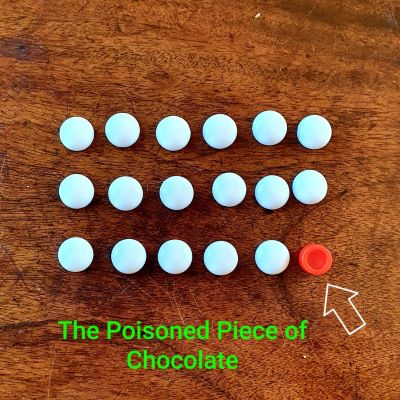
This is a popular and ancient game with many variations. See our friend Kjartan Poskitt with his unique take on the take-away game in the video below.
What you will need:
- 18 counters
- You can use coins, pebbles, pegs, bottle-tops or anything else you can think of.
INSTRUCTIONS:
- Mark one of the counters as the poisonous chocolate
- A go consists of removing up to 4 counters
- Player A goes first by removing either 1,2,3 or 4 counters
- Player B moves next and removes either 1,2,3 or 4 counters
- The player who is left with the poisoned piece of chocolate loses
For: primary pupils and older
Sunday 29/03/20
Make a working Sundial
What you will need:
- Printed Sundial Template (See button below)
- Scissors
- Sellotape
- Sunshine (unfortunately necessary)
INSTRUCTIONS:
-
- Print out our Sundial template
- Cut out the gnomon. This is the piece that will cast the shadow
- Fold up along the dotted lines and then fold back along the solid line in the middle (pic 2)
- On the dial cut along the broken segment of the centreline
- Slip the gnomon into this slit aligning it with the base of the dial as in the picture (pic 3)
- When it is in position put a small piece of tape on the underside to keep it from moving. (pic 4)
- Place your dial on flat surface and align it.
- The sun is at its midpoint (noon) at Greenwich, London at 12 O’Clock (but this does vary). Because we are to the west the Sun will not be at it’s midpoint until later.
- So you can align the sundial to the north and subtract the time difference or you can align it for your local noon. We have East Coast and West Coast. You will have to estimate if you are in between.
- If you have a smartphone with a compass align the side of your smartphone with the appropriate arrow and turn dial and phone until your phone pointer is indicating north. (pic 5)
- If you have a magnetic compass do similar. But because a magnetic compass doesn’t point to true north you have to use a different correction.
- If you don’t have either or you don’t know where north is, you can align the sundial using the time from a watch or clock. This will be most accurate if you can do it on an hour mark.
- If the sun is out then you can use your sundial. Make sure it is held down so that it doesn’t blow away. (pic 6)
The Poisoned Piece of Chocolate
For: Primary and older
Monday 30/03/20
A mathematical game of strategy for two players. This is a variation of Nim, a game that has been played in different forms since ancient times and is often called the Takeaway Game
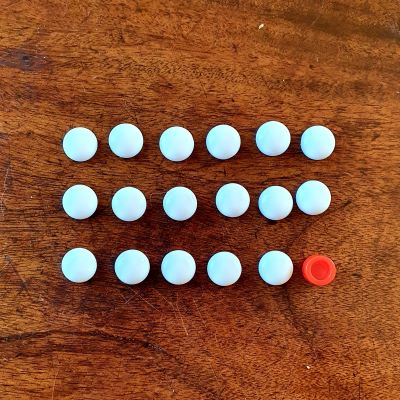

This is a popular and ancient game. See our friend Kjartan Poskitt with his unique take on the take-away game in this video
What you will need:
- 18 counters
- You can use coins, pebbles, pegs, bottle-tops or anything else you can think of.
INSTRUCTIONS:
- Mark one of the counters as the poisonous chocolate
- A go consists of removing up to 4 counters
- Player A goes first by removing either 1,2,3 or 4 counters
- Player B moves next and removes either 1,2,3 or 4 counters
- The player who is left with the poisoned piece of chocolate loses
Need a Hand with Maths?
For: HANDS-on activity for pre-school and younger primary pupils
Friday 27/03/20
Make sums of 10 by folding the fingers down and counting
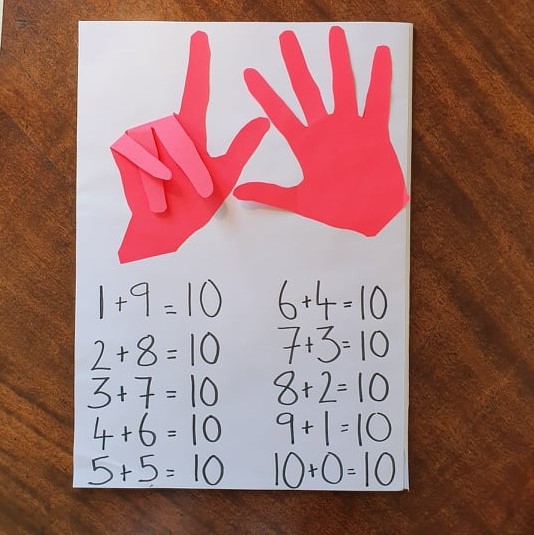
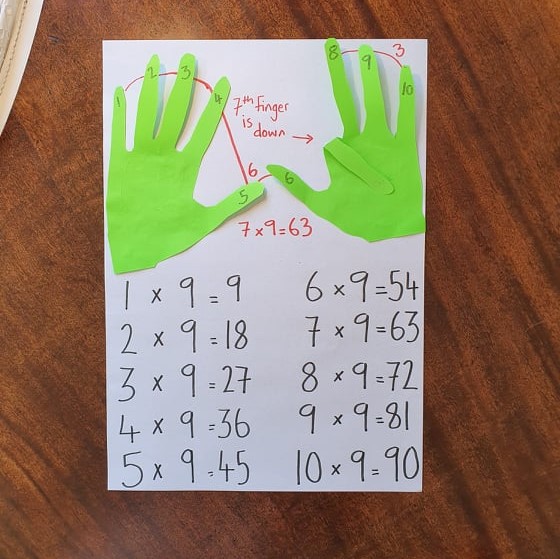
This is a popular pre-school activity. We don’t know the origins
What you will need:
- Coloured Paper – use recycled magazine or newspaper for a sustainable option
- A3 Paper
- Pencils or markers
- Scissors
- Glue or Sellotape
INSTRUCTIONS:
- Students trace their hands onto the paper
- Cut out the pair of hands
- Glue down the hands onto the A3 page, except the fingers
- Make sums to 10 by folding the fingers down and counting
- Record the sums underneath
The Magic of Möbius Strips
For: Nice activity for primary pupils but will amaze all ages
Thursday 26/03/20
Hands-on activity: a Mobius Strip is an object that defies common sense and has some curious mathematical properties
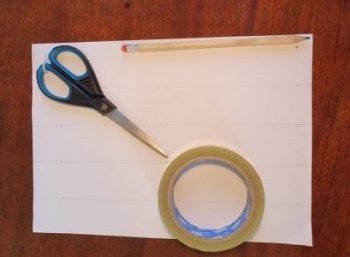
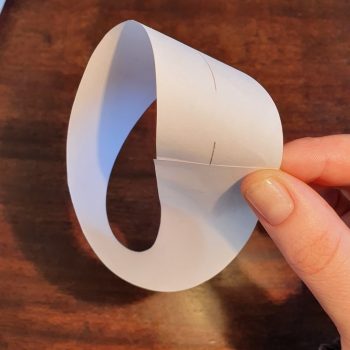
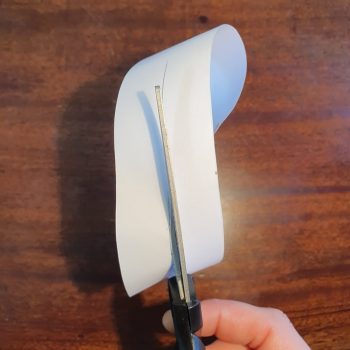
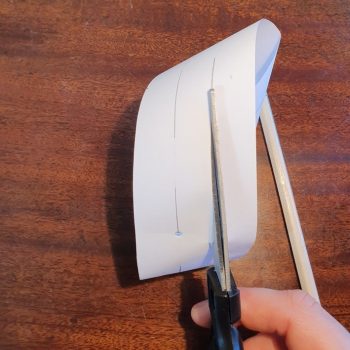
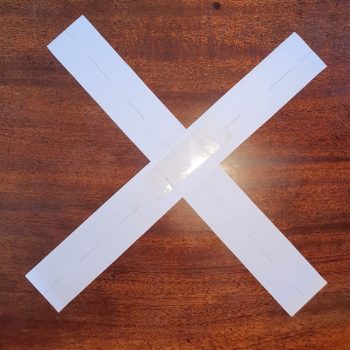
The Möbius Strip is called after German Mathematician August Ferdinand Möbius (1790 – 1868) but it is believed to have been known in Roman times.
You can see our friend Douglas Buchanan’s expert demonstration of Möbius Strips.
What you will need:
- Paper
- Ruler
- Pencil
- Scissors
- Sellotape
INSTRUCTIONS:
- Cut a strip of paper approximately 30 cm long and 4 cm wide. (Divide an A4 page into 5 long strips)
- With a pencil and ruler draw a dashed line along the centre of the strip, lengthways
- You are going to join the two narrow ends of the paper together but first make a half a twist with one end.
- Tape the two ends together. This is called a Möbius Strip
- Trace along the centre of the strip: do you come back to where you started?
In Mathematics the Möbius Strip is considered to have only one side, because you can travel around a Möbius Strip and arraive back at your starting point.
Make Ten Again!
For: Younger Primary Children. Variations for older primary up to adults
Wednesday 25/03/20
This is a great activity to practice addition in a fun way. It can be extended to include subtraction and also multiplication and division. Older children can try our more advanced games.
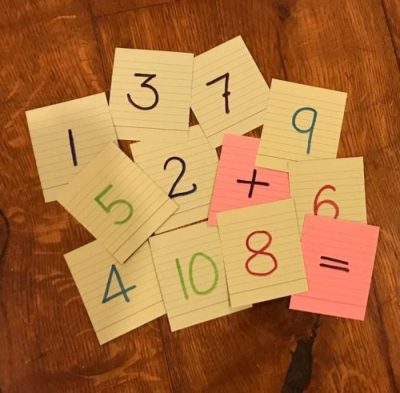
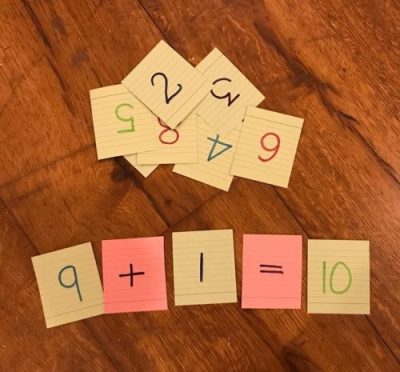
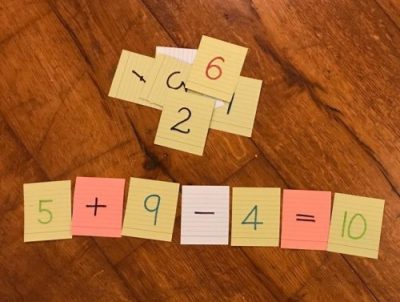
This is a popular activity. There are many variations of it online and we don’t know the original source. We developed this version to allow lots of different levels of challenge.
What you will need:
- Cards or paper cut to size (Post-its will do)
- Scissors
- Markers
INSTRUCTIONS:
- Cut out 12 cards
- Number the cards 1-10 in big writing
- Write the symbols + and = on the last two cards
- Lay out all the cards on the table
- The challenge is to make up the value 10 using various cards
- You can do this by picking a number and asking the child to find the number that will make up 10 with the chosen number.
- Lay out the cards into a proper sum i.e. 1+9 = 10
Butterfly Symmetry
For: Younger Primary Children
Tuesday 24/03/20
This activity brings maths and art together, exploring symmetry. If you have water-based paint and paper and a scissors you are ready to go.
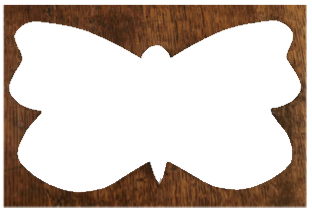
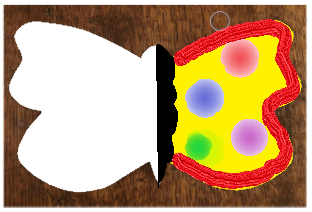
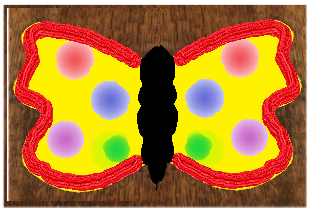
This is a popular activity, we dont know the origin of it.
What you will need:
- Sketchbook or thicker paper
- Black construction paper ( optional-for a body)
- Glue Stick (optional – for body)
- Paintbrushes
- Paint
- Palette
- Scissors
- Pencil
INSTRUCTIONS:
- Pull out a sheet of paper from your sketchbook, or you can use any kind of thicker paper you have to hand. Placing it horizontally in front of you, take the left side and fold it in half so the left side touches the right.
- Draw one side of a butterfly on the folded sheet. Make sure that you draw the body of the butterfly on the fold of paper.
- Using scissors cut out the butterfly, making sure you are cutting both sides of the paper. If your children are confident with a pair of scissors, by all means let them do the cutting. Otherwise, a parent or guardian should do this part.
- Using the paints liberally, colour in one half of the butterfly.
- Fold over the paper and press together to ensure the paint transfers to the other half.
- Open up the paper and you will see a symmetrically shaped and coloured butterfly.

